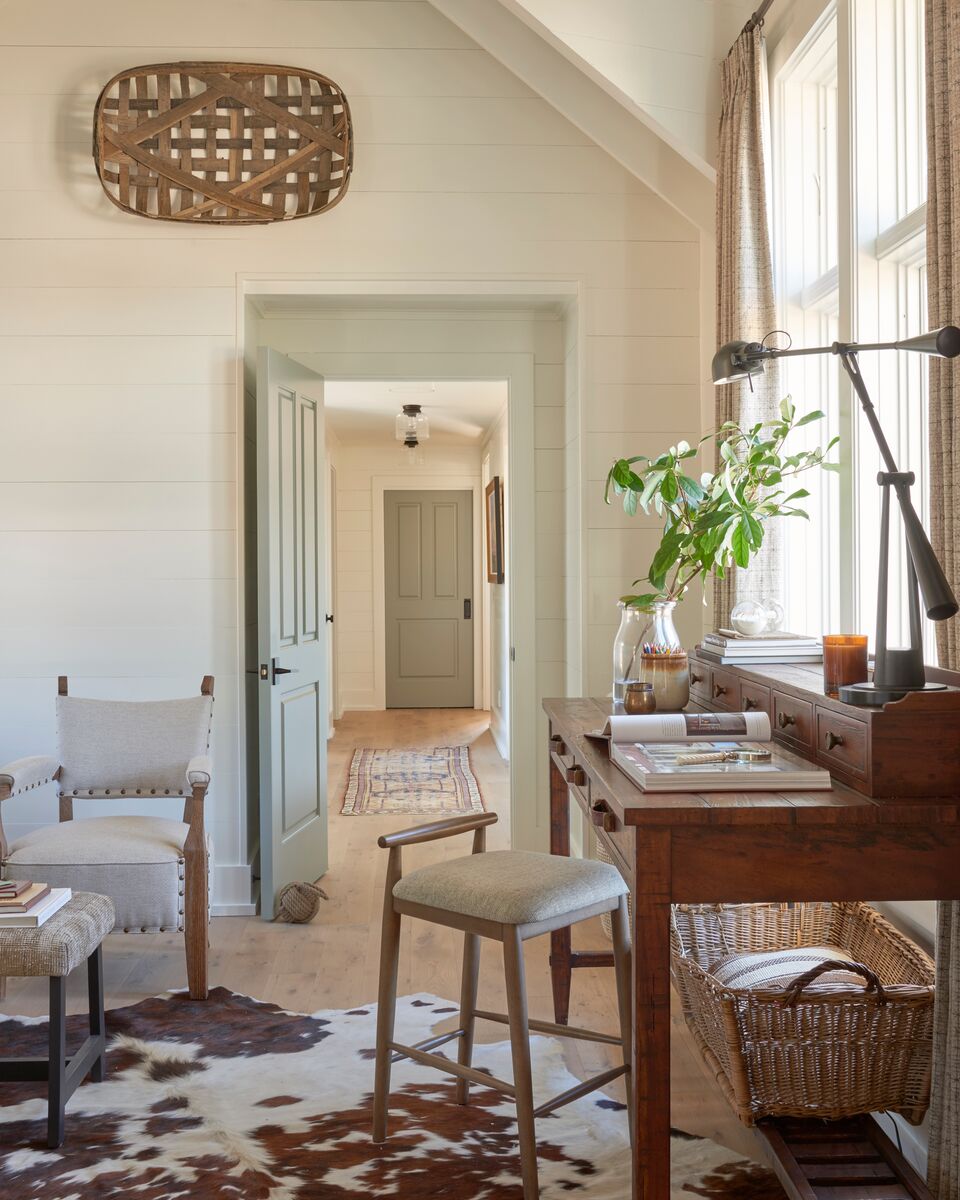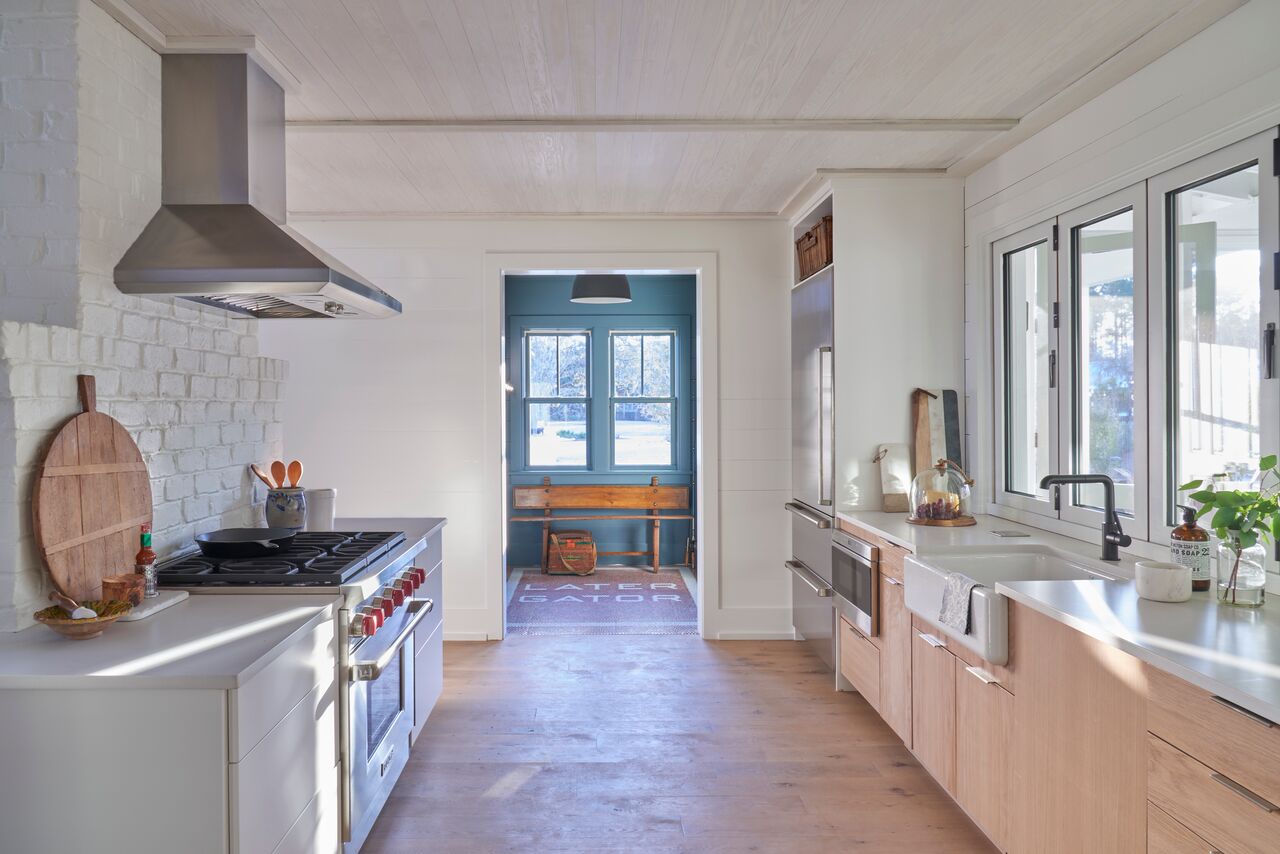Bette Ridgeway creates magic. She pours her heart and soul into the artwork that she creates. When the American abstract artist felt the rush of loneliness during the COVID-19 lockdown in her Santa Fe, New Mexico home, she turned that feeling into a work of art. With tones of grey, blue-grey, and white, Ridgeway let the paint (and gravity) speak for itself. She stepped back and knew that the name of the painting was Loneliness.
Ridgeway doesn’t use any paint brushes. Her canvases don’t sit atop an easel. Instead, she uses acrylic paint, a canvas, stools and plastic cups. The rest, she leaves to gravity.
“I call the technique ‘pouring’ and use the phrase, which I copyrighted, ‘layering light,’” Ridgeway explains.
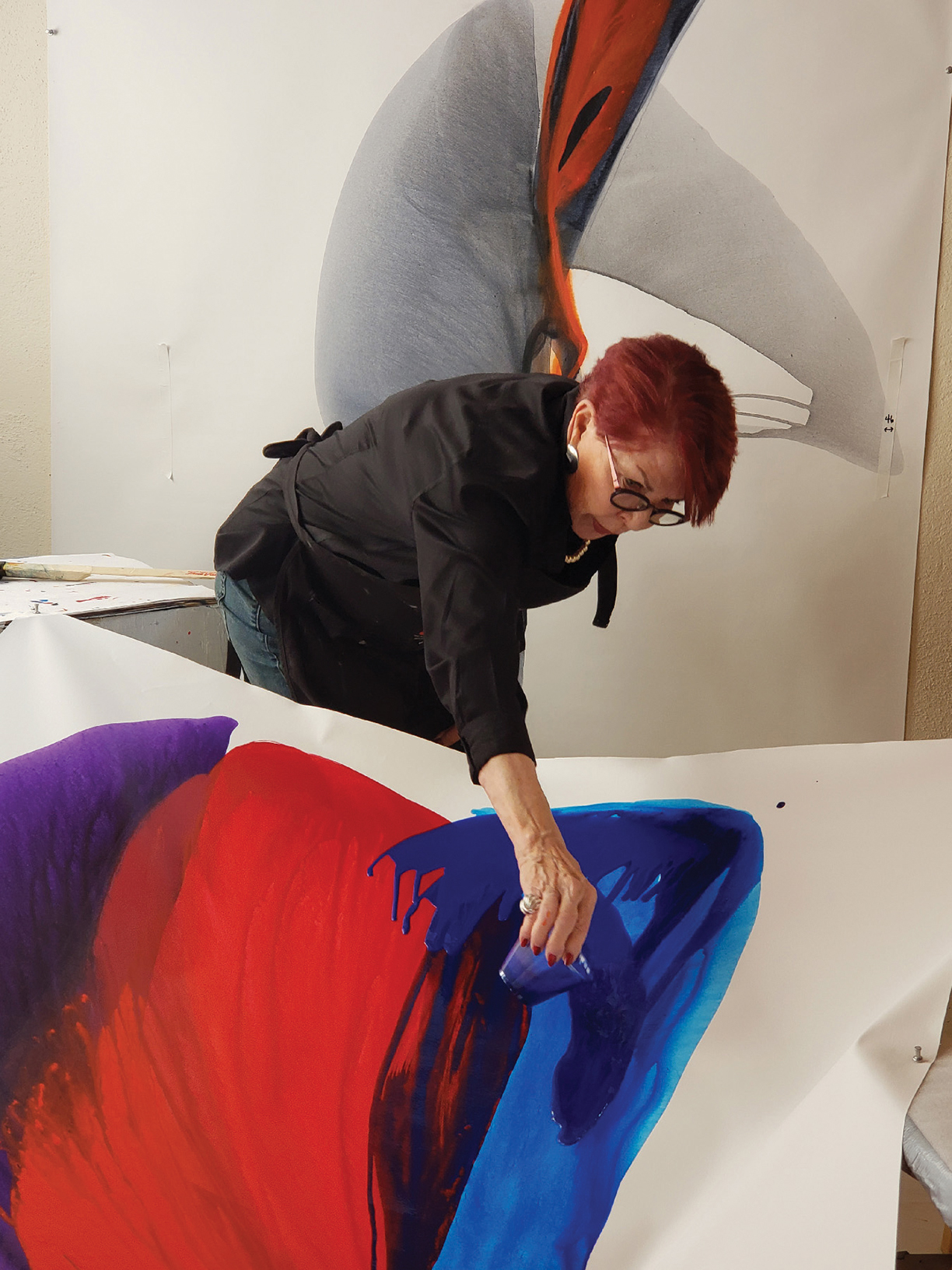
Bette Ridgeway
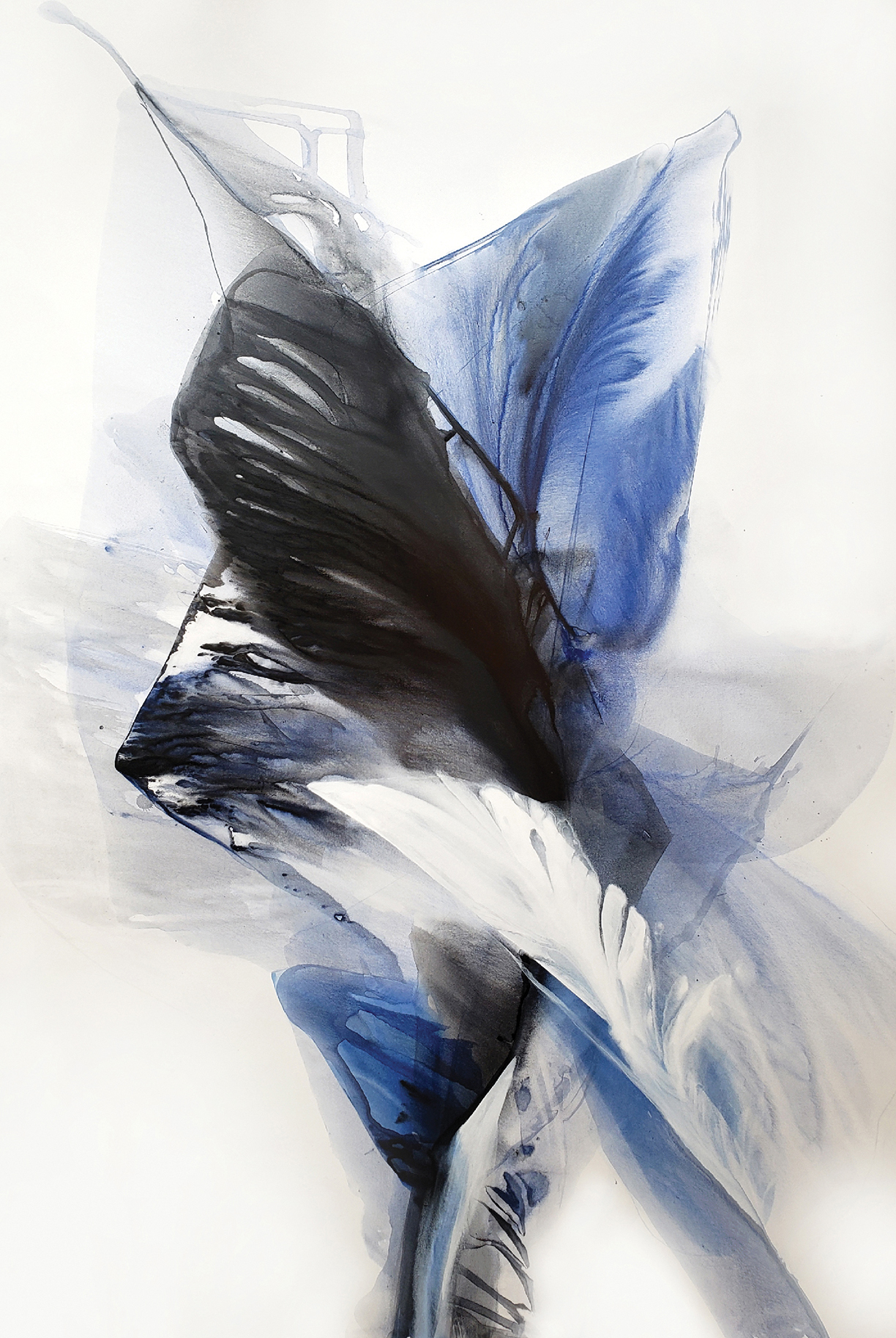
Lonliness
The artist accomplishes the “layering light” look by mixing her paints in her nine-inch plastic cups, where she then pours the colorful mixture on her canvas. Ridgeway explains that she manipulates the canvas by stretching it over stools and ladders, allowing the paint to create her signature style. “If you look at the work, you’ll see there’s motion in it and that’s achieved by the speed of the pour, the angle of the pour and that’s what makes it unique, no brush work,” says Ridgeway.
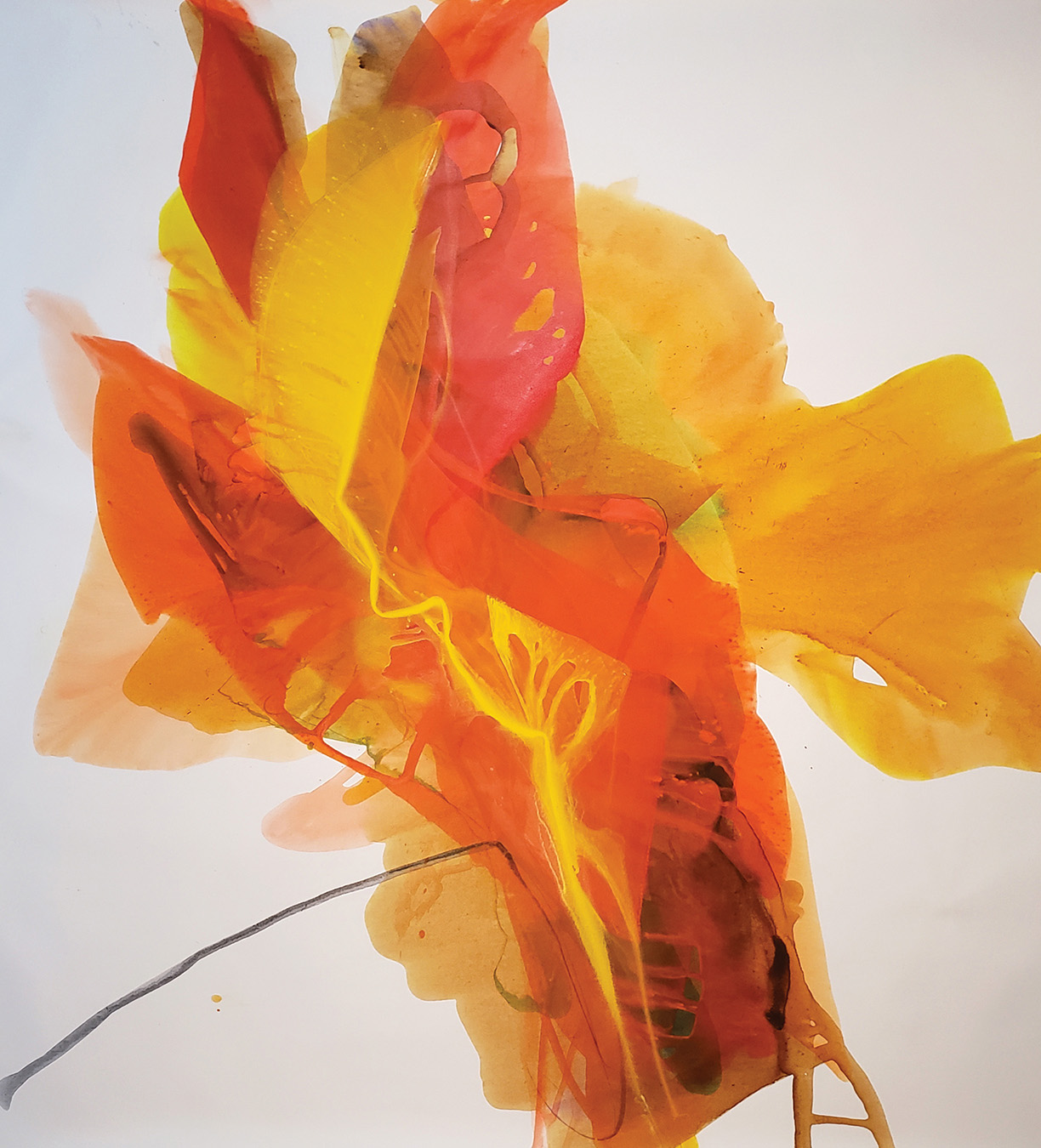
Fandango — Inspired by New Mexican flamenco dancer María Benítez. The twists and turns of the orange and red reminded Ridgeway of the dancer flowing and dancing the flamenco.
With over 30 years of experience as a commercial painter under her belt, Ridgeway has an endless portfolio of paintings, each with its own look. “Every single one of them is so different,” she explains. “Some are really bold and strong. Some are lighter and more transparent. Transparency is what makes the work different because when you pour a watered-down color over another watered-down color, you get a third color. You compose as you go.”
As an abstract artist, Ridgeway says, she pulls inspiration for her pieces from a memory, a feeling, or simply a color combination she envisioned or saw. “I don’t set out to paint something,” she says about when she approaches her canvas to paint. “I don’t set out to paint happiness or joy, or anything like that.”
Instead, Ridgeway takes what’s inside of her at the time and lets the colors and the pour shape the painting. This is one of the things that led Ridgeway to transition from figurative painting (painting an object or subject that is real) to abstract painting. “Abstract work is harder because it comes from inside you, you’re not looking at anything. You’re painting a thought, a feeling,” she says. “You’re painting a certain thing that’s come outside of you.”
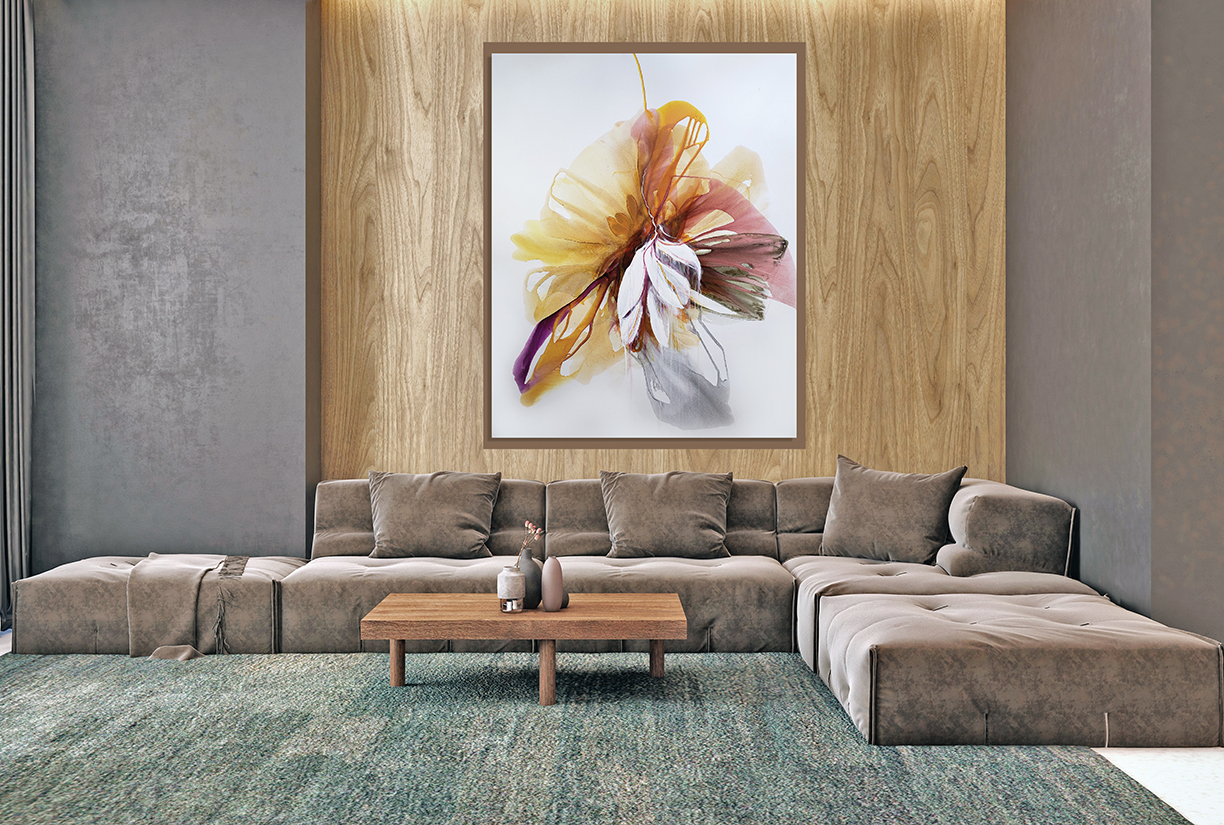
Harvest Time — “When I started out, I wanted to use earth tones — amber and gold and a little bit of gray — more earthy than primary colors.” Ridgeway explains that when she threw the deep raspberry color and the white on the canvas, it reminded her of the rainforest. She squirted water in the center of the painting and let it drip. “A lot of people don’t know rainforests, but it’s like a soft, misty rain the whole time, so moist,” Ridgeway says. “Fruit everywhere, flowers everywhere, so you get that feeling of Mother Earth, just so abundant and rich and lifegiving.”
When a dear friend of Ridgeway’s passed away in 1999, the feeling that came out of her was sadness. To cope, she took this feeling and created a masterpiece. “I did this gigantic piece with only red and black, on a white canvas and I named it, Mi Corazón Roto, which means ‘my broken heart.’ And it looked like that, to me — an abstract broken heart.” It hung in her studio for a long time, until a best friend and collector of hers lost her husband. Ridgeway gifted the painting to her “and she hung it in her living room and it was like her broken heart,” she says. Ridgeway got the painting back after her friend passed away, saving it from being sold in a consignment shop. “So each piece kind of has a life of its own,” she says, going on to share that the piece recently found a new wall to call home.
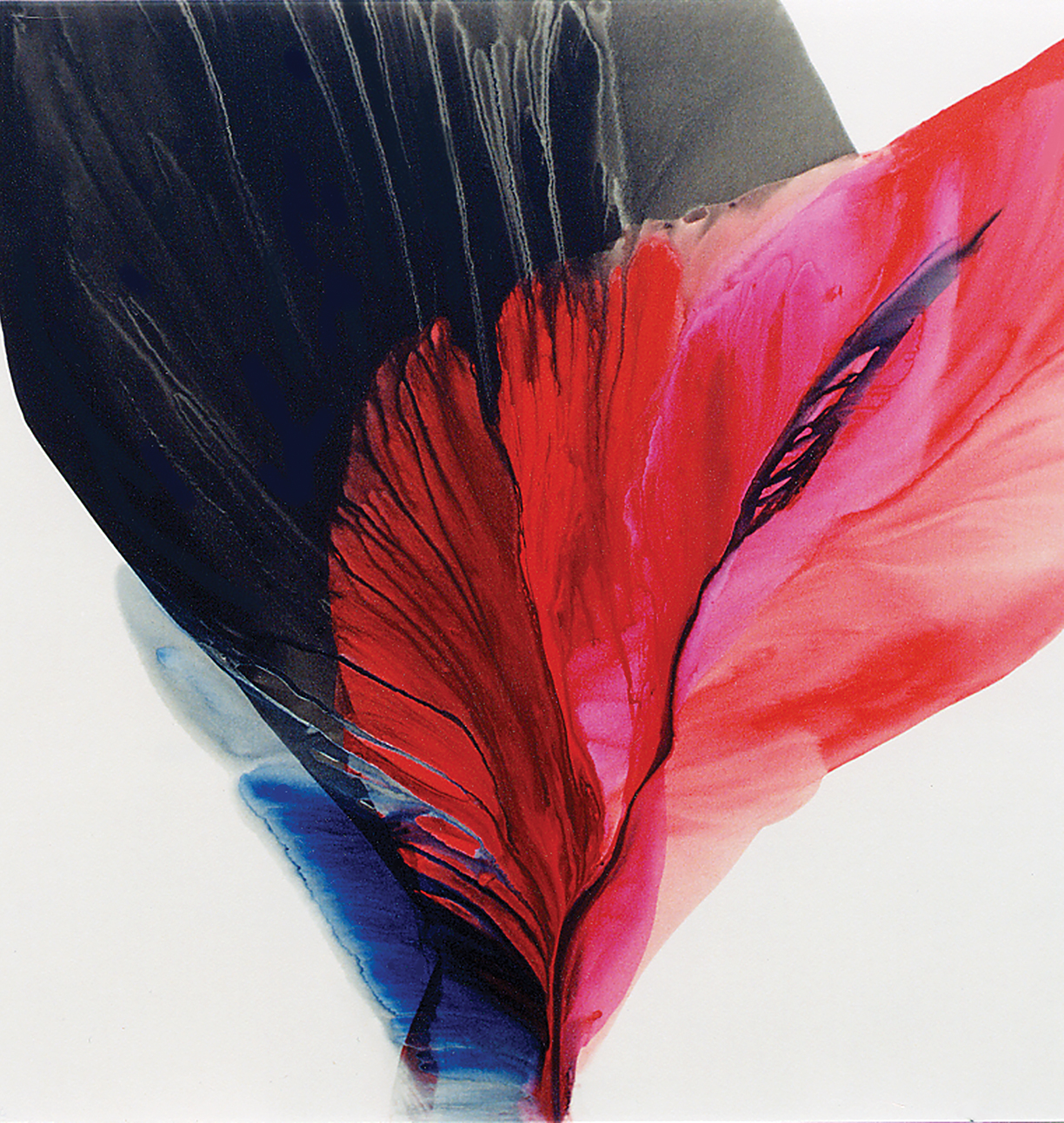
Mi Corazón Roto
One of the best parts of what Ridgeway does is when people get to see her paintings. “The viewer is actually the one that completes [the painting] because they see what they see and it might not have anything to do with what I did,” she says. “It’s so much fun to hear what people see. It’s never what I see.”
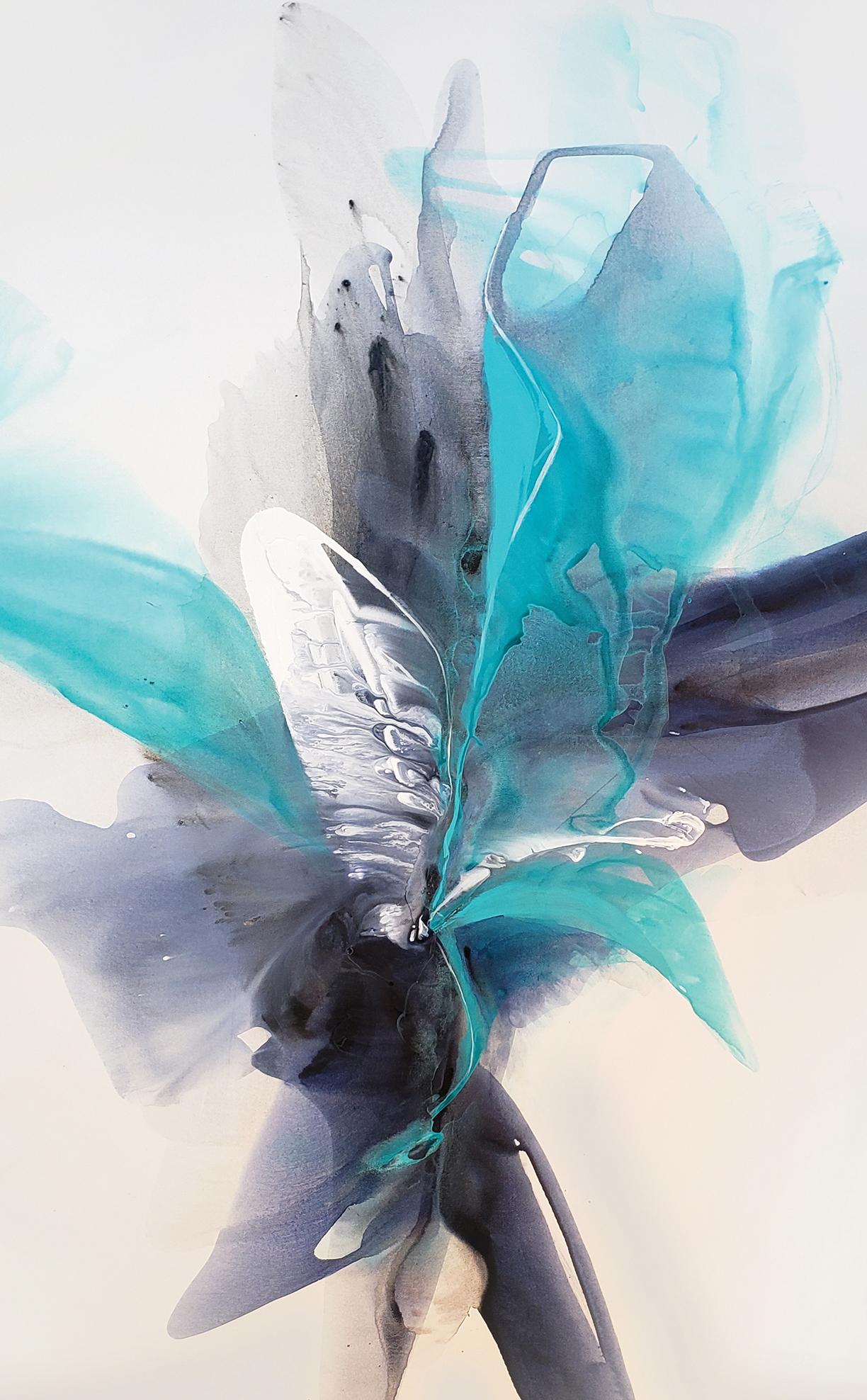
A Day in the Surf — “You know, with this COVID, we’re not able to travel, at least I’m not, and so I’m missing going to a beach this summer, I’m missing the water,” Ridgeway explains about this piece. Inspired by the water, Ridgeway created this piece that is reminiscent of the beautiful ebb and flow of the waves on a beach.
In a way, Ridgeway has come full circle in her career. In the mid 1970s, the artist visited a big gallery in New York to see the work of abstract artist Paul Jenkins, who used the same method of pouring in his work. “The paintings were enormous and they were in primary colors — red, blue, green, orange, yellow, a lot of black — and it just brought me to my knees,” Ridgeway says. “I had never seen anything like it and it was so powerful, and this entire gallery, with huge walls, was filled with this magnificent work, that I just stood there and cried. It was so beautiful.”
It is Jenkins, according to Ridgeway, that led her down the path to finding her creative voice. “I owe so much to my friend Paul who became a mentor over the years,” she says. “He passed away in 2012 and was a master, his work is in all the major museums in the world.”
Although Ridgeway has accomplished so much during her career and continues to show in galleries and paint commissions, she acknowledges she still has room for growth, “I’m learning every day. I don’t have all the answers,” she says. “And that’s the beauty of this work, it’s so different and every single day I learn something new. And that’s what’s exciting…. I’m just having the time of my life.”
For more information on Bette Ridgeway, upcoming showings, and paintings, go to RidgewayStudio.com or BetteRidgeway.com
Photos of artwork and Bette Ridgeway courtesy of Bette Ridgeway.
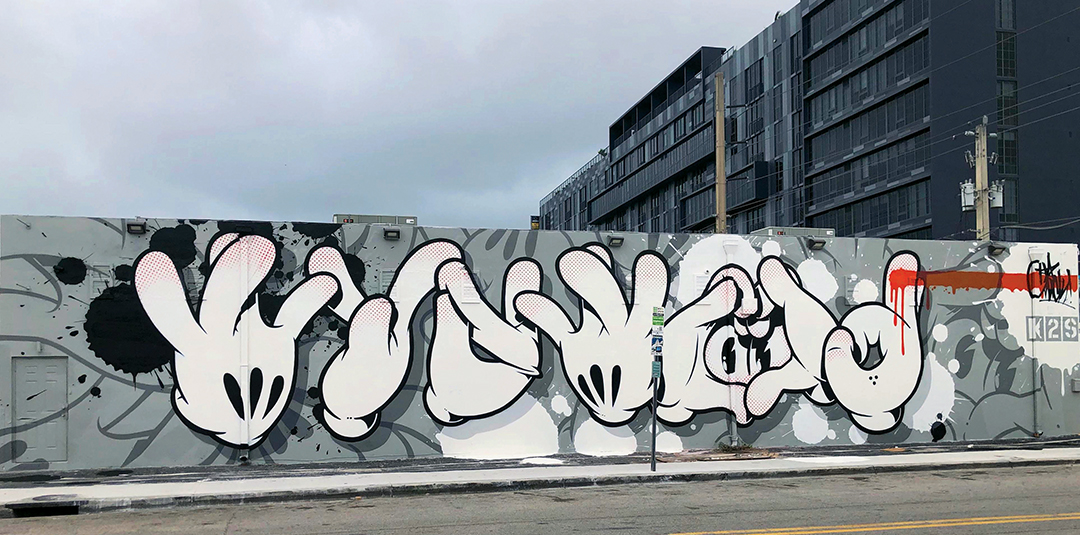
Slick, a native of Hawaii, painted this mural on the exterior of the Museum of Graffiti in Miami.
Photo courtesy Museum of Grafitti.
Its earliest practitioners were considered criminals, but now the work of some graffiti artists hangs in the nation’s most prestigious museums.
After society’s initial outrage over acts of vandalism in the name of creativity, art enthusiasts begrudgingly acknowledged that some wayward, urban painters were genuinely gifted. Over time, graffiti and street art earned a place in prestigious collections, private galleries and museums like the Museum of
Contemporary Art (MOCA) in Los Angeles and Whitney Museum of American Art in New York.
While graffiti is often viewed as an American-born genre, Michael Rooks, a curator of modern and contemporary art at Atlanta’s High Museum of Art, provides some historical context. “Graffiti and street art have their origins in the history of 20th century art — from Dada wherein text replaced image to inveigh against WWI on the streets of Zürich, to the Mexican muralist movement’s large-scale murals in post-revolution Mexico City, to Les Affichistes artists whose affiches lacérées (layers of torn posters and advertisements) were literally sourced from the streets and walls of post-WWII Paris.”
The evolution of American street art has been well documented in L.A. and New York, but the acceptance of this form of artistic expression has also occurred in Philadelphia, Miami, Chicago, and San Francisco.
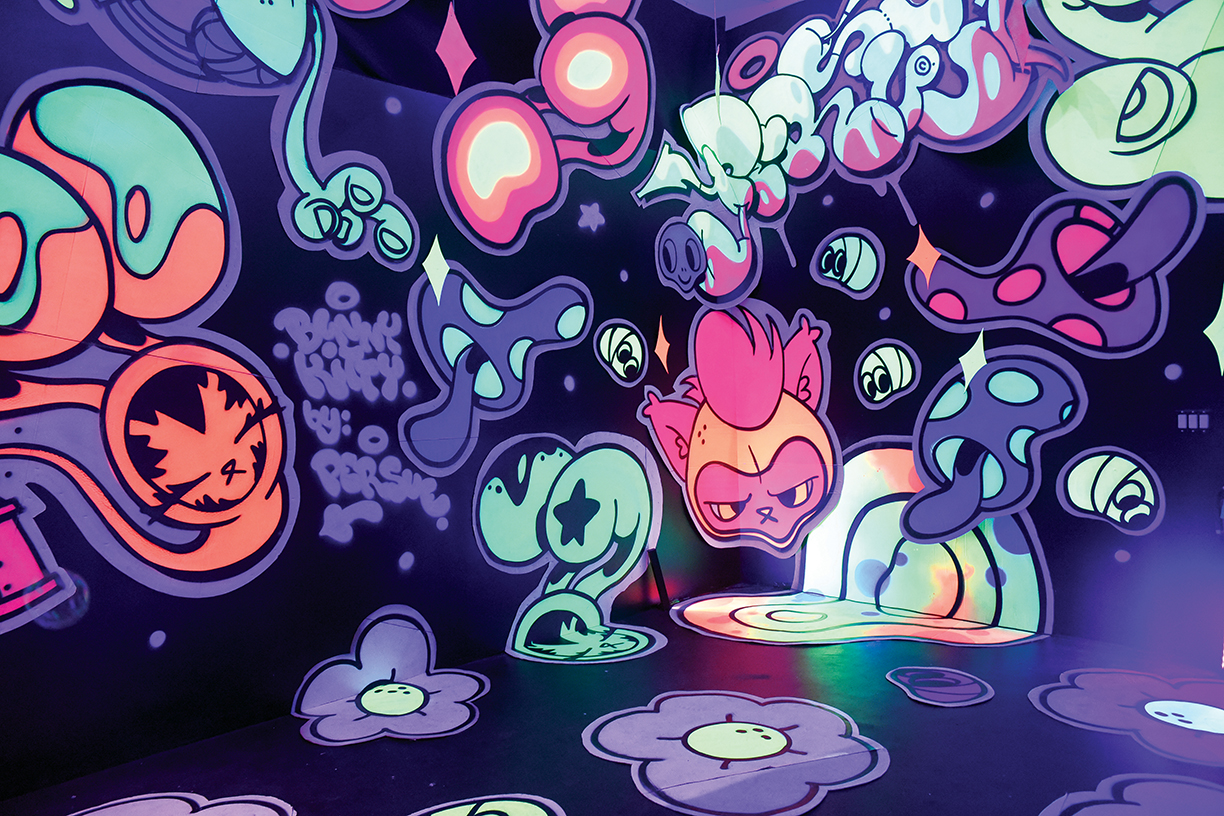
“Bunny Kitty’s Dreamstate Room” is a vibrant, playful work from artist Persue.
Photo courtesy Museum of Graffiti.
Some street artists are commissioned as muralists, a transition that monetizes and legitimizes their work, before eventually being discovered by curators. Ultimately, gallery representation leads to their art appearing in chic restaurants, hotels and private collections. Artists like Keith Haring, Jean-Michel Basquiat and Shepard Fairey — all once confined to the fringes of the art world — became creative celebrities. In L.A., the exclusive fashion boutique of Elyse Walker features artwork by RETNA, one of the most prominent local street artists, while superchef David Chang hangs the work of David Choe in Majordomo, his popular downtown restaurant. The city’s Mayfair Hotel features the work of a different street artist on every floor — resulting in diverse visual experiences for guests — and is a tribute to the depth of talent in the region.
The historic Mayfair, site of the first post-Academy Awards party in 1929, has been transformed into a trendy setting showcasing street art, curated by artist-in-residence Kelly “RISK” Graval. The Louisiana-born artist became one of L.A.’s most influential graffiti stylists and was among the pioneering artists to transition from the street to the gallery, as well as entering the worlds of fashion design and music video.
RISK’s own work is represented by a Buddha-inspired installation on the second floor and one of his murals will eventually soar above the 15th-floor pool deck. “I selected my “Metallic Tissue” series, which consists of a body of work that I paint on panels built out of repurposed spray cans,” reports RISK, who states, “They’re my imprint on society as an artist, my DNA.” He also installed some of his unique neon work in the lobby, which suits the vintage of the building. Overall, nearly 100 pieces throughout the hotel represent the diversity of L.A.-based graffiti artists and muralists like DEFER, Billy Morrison and Shepard Fairey, whose breakout work was the Barack Obama “Hope” imagery from the 2008 presidential campaign.
“There was a time when graffiti artists were a small underground subculture,” explains RISK, but adds, “The powerfully dynamic art sparked a younger generation and it exploded.” He acknowledges that street art festivals and museum exhibits helped elevate the genre within the polite corridors of the art world, but that true recognition has been stubborn.

Neon work from RISK, the artist-in-residence at The Mayfair Hotel in L.A. Photo courtesy the Mayfair Hotel.
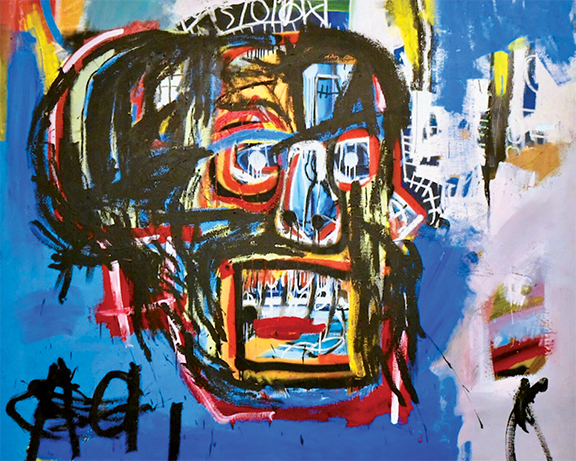
This untitled painting of artist Jean-Michel Basquiat sold for $110.5 million at auction. Photo courtesy Museum of Graffiti.
“It was time for a new generation to take over. The old guard and practices of art began to change,” insists RISK, who suggests progressive hoteliers are helping idiosyncratic artists to find an audience. “Hotel art was becoming stale, kind of like Muzak in elevators in the ’80s, and needed a new approach,” says the veteran artist. “Boutique hotels like The Mayfair are ahead of the curve and breathe fresh air into an exciting future for art, artists, and art enthusiasts,” says RISK.
Roger Gastman, an urban anthropologist and historian, is a leading authority on street art who counts The History of American Graffiti and Street World: Urban Art and Culture from Five Continents among his 50 books. Gastman remembers his own discovery of self-expression — through a spray paint can in the early 1990s — as a defining moment in his young life.
Gastman, whose first book, Free Agents: A History of Washington, D.C. Graffiti, documented the local culture he experienced in his youth, reports there is a distinction between graffiti and street art. “Graffiti is very name-based, very ego-driven, while street art is more image-based and involves additional tools and techniques,” says Gastman, but notes that both have their roots in vandalism. “Street art is a safer name and is more digestible to the public, but graffiti and street art are kissing cousins on the same playing field,” he muses.
“So much of this work is fantastic and deserves to be seen in a different light, collected and respected,” says Gastman, who laments, “A majority of galleries and museums still don’t accept this kind of art, look at it seriously or believe it should be shown.” Demographics, however, are driving attitudes, suggests Gastman. “People in their 30s and 40s grew up with graffiti, tattooing and skateboarding — it’s everywhere, in fashion, music and advertising — and it resonates with them.”
Last year, Gastman spearheaded the New York edition of Beyond the Streets, a massive 100,000-square-foot exhibition of prominent graffiti artists in Brooklyn, following a similar event in L.A. in 2018. “We basically built our own museum and 200,000 people walked through the doors,” he explains, adding, “It showcased graffiti and street artists, giving them respect and presenting their history in the proper light.”
Miami, whose Wynwood Arts District is defined by vibrant, multicultural murals, is a city with a strong tradition of street art, and its Museum of Graffiti pays homage to the approachable medium. Museum co-founder Allison Freidin explains, “Our goal is to celebrate a group of artists previously marginalized because of the stigma associated with graffiti,” and reports the Miami institution is the only one in the world exclusively dedicated to graffiti art. “Previously, there was no place to learn about these artists,” she adds.
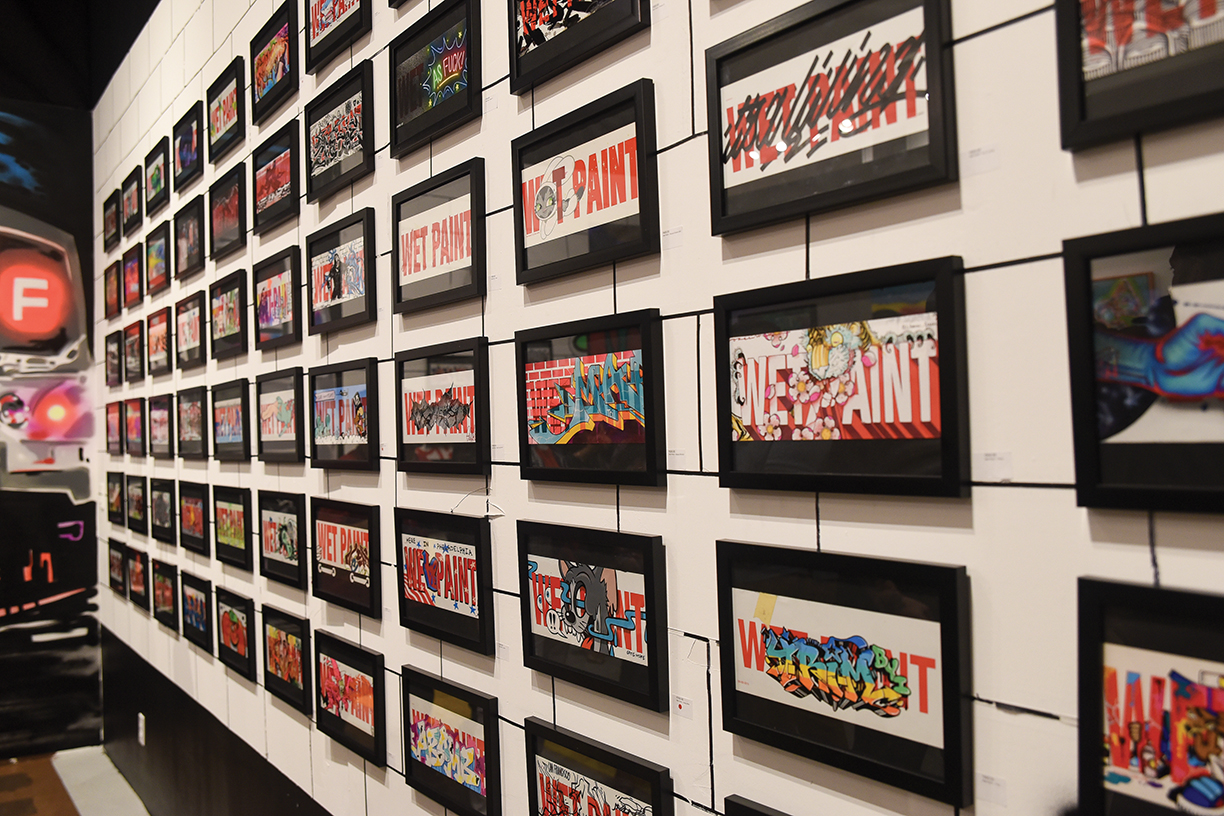
Above: The “Wet Paint” exhibit at the Museum of Graffiti in Miami, from artist Persue. Photo courtesy Museum of Graffiti.
At Right: “Party Felix” by Seen, one of many artists showcased at L.A.’s Mayfair Hotel. Photo courtesy the Mayfair Hotel.
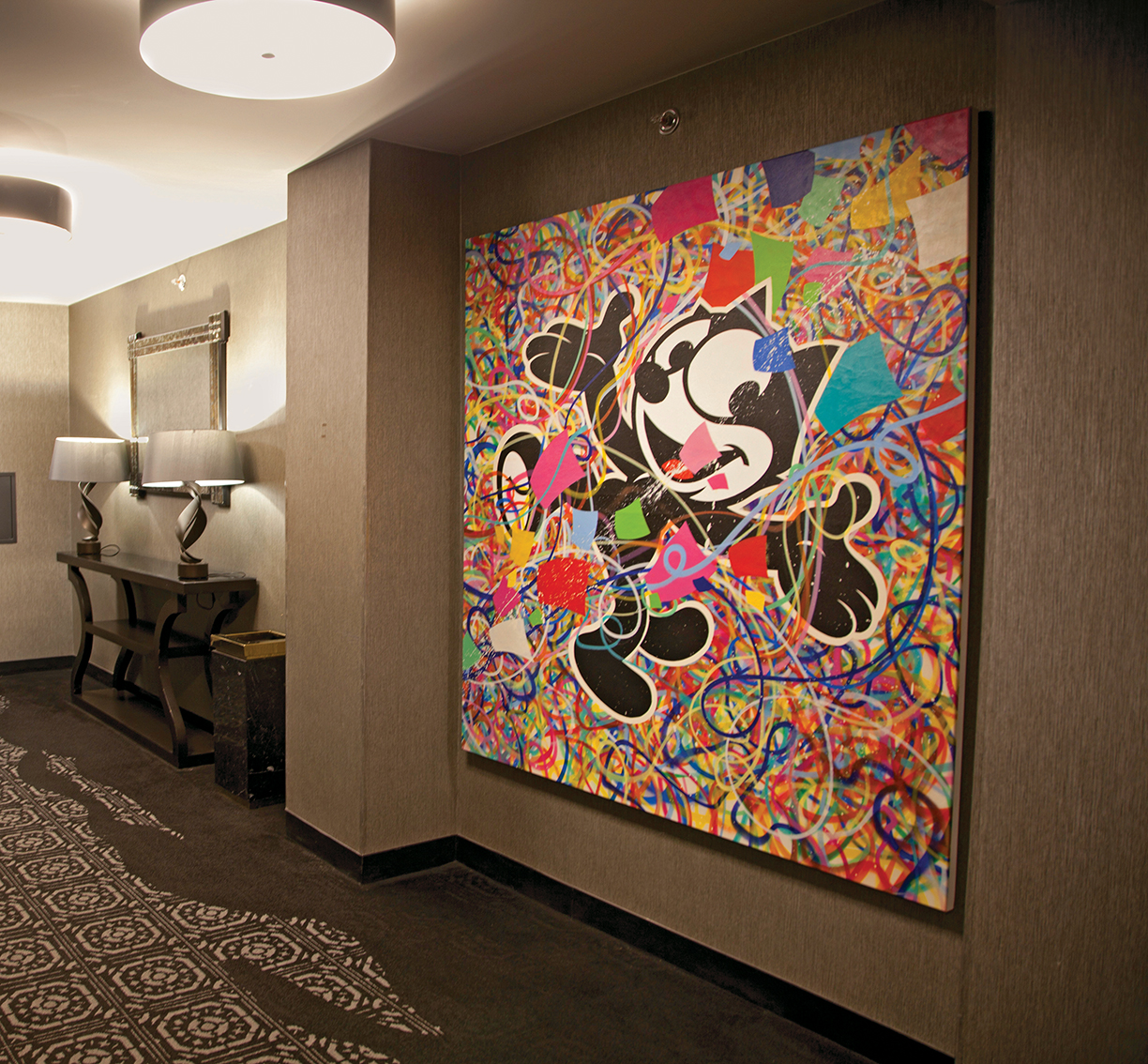
Explaining its location in a former shoe warehouse in Wynwood, Freidin reports, “The district’s relevance in the past 10 years is a product of the graffiti art that transformed a sleepy industrial neighborhood into the world-class arts destination it has become,” noting the windowless warehouses made ideal canvases for street artists. The Museum of Graffiti’s own building is entirely wrapped in 14 different murals by acclaimed local and international artists like Shoe, EZO and Abstrk.
The museum’s interior galleries feature rotating exhibits such as a recent compelling vignette from artist Persue, who famously removed the “Wet Paint” signs that New York City transit workers used to tape to subway cars after painting over graffiti art. Persue sent more than 70 of those very placards to artists around the world to use as canvases, all of which were incorporated into an exhibit whose physical design resembled a New York subway station platform.
Freidin explains that Miami’s graffiti art movement began in the early 1980s when some youth who got into trouble in New York were sent to South Florida to live with grandmothers or aunts. Insisting there is no way to repress the energies of an artist, Freidin reports, “The art erupted like a vengeance.”
The museum co-founder applauds the success of local graffiti artists like José Parlá, whose work moved from the streets of Miami to a mural inside Manhattan’s One World Trade Center, as well as multiple museum exhibitions and commissions in Tokyo, London and Havana. “He was immensely talented and continued to put in the work despite the stigma associated with graffiti art as vandalism,” says Freidin, who adds, “He’s probably one of the biggest names in contemporary art in the world.”
It was not easy for some museum curators to persuade their boards of directors that people previously labeled as vandals should be showcased in world-class fine arts facilities, but Freidin maintains society has evolved. She offers the former criminalization of marijuana as an analogy, citing its progression from disdain to broad acceptance. “It takes forward-thinking arts enthusiasts to take a risk,” and reports major corporations are hiring these artists as creative directors. “They recognize the power of this art,” says Freidin.
Robert Michael Provenzano, professionally known as CES, is a leading graffiti stylist whose signature aesthetic is now influencing the generation of artists currently emerging from the streets. His art, which began almost 40 years ago in his native Bronx, repeatedly got him into trouble as a young man, but after being flown to Munich to demonstrate his craft at a museum he realized there was a market for his skills. “My friends and I used to have to steal supplies, but now I’m a sponsored artist by a paint company in Barcelona,” says CES of how attitudes toward graffiti art have changed.
CES has since earned commissions from Nike and Palms Casino Resort in Las Vegas, in addition to collaborating on a mural adjacent to Miami’s Museum of Graffiti, where he was recently headlined. He finds it ironic that the artistic expression that was so strongly discouraged when he was a teenager is now a source of pride for his family. “I had no idea that if I stuck with it all those years, the whole world was gonna dig it,” reports CES.
The High Museum’s Michael Rooks notes, “The migration of some graf artists into the mainstream via museum collections and exhibitions underscores a familiarity with the language of the street that is widely recognized among urban audiences, as well as the influential role it has on global visual culture today.” He adds, “A fulcrum point in the migration from the street to the museum has to do with an artist’s knowledge and understanding of this legacy and ability to speak with urgency and artistry to contemporaneity.”
The ultimate measure of acceptance of art is the monetary value it commands in the marketplace. In 2017, an untitled work of Jean-Michel Basquiat, who began his career spray-painting walls in Lower Manhattan, sold for $110.5 million to a Japanese billionaire at auction, eclipsing his own personal record of $57.3 million.


Photos by John A. Peralta
John A. Peralta began taking things apart long before he was compelled to truly pursue art. “I was always breaking things open to see what was inside. I’ve had such wonder for the tiny components that make something work,” he says.
Now a self-taught artist based in Austin, Texas, Peralta has a unique taste for both science and how things work as well as art. While working as a business consultant, he began painting as a way to tap into and satiate his creative side. The exploded diagram, which has been an essential engineering tool, melds Peralta’s contrasting interests and inspired his work.
An exploded diagram of a bike on the back of a magazine was Peralta’s original inspiration, but since then, his work has begun to evolve over the years. “It’s more about a concept that imagines that these machines we use — that we often take for granted and use every day — they hold our memories,” according to the artist. “And sometimes in literal ways. The typewriter has an imprint of every letter, every document permanently imprinted on it. It could never be deciphered today, but nevertheless it’s in there.”
Peralta’s art reveals the inner workings of a time in history or a memory. The contrast between machinery and emotion creates enchanting displays and elicits a feeling when you see them. The idea of machinery holding memories extends to all of our objects, according to Peralta. “It’s why we become nostalgic years after for antiques or whatever it might be. We attach emotion to these things and they hold our memories and it’s sort of two-way relationships with the objects in our life.”
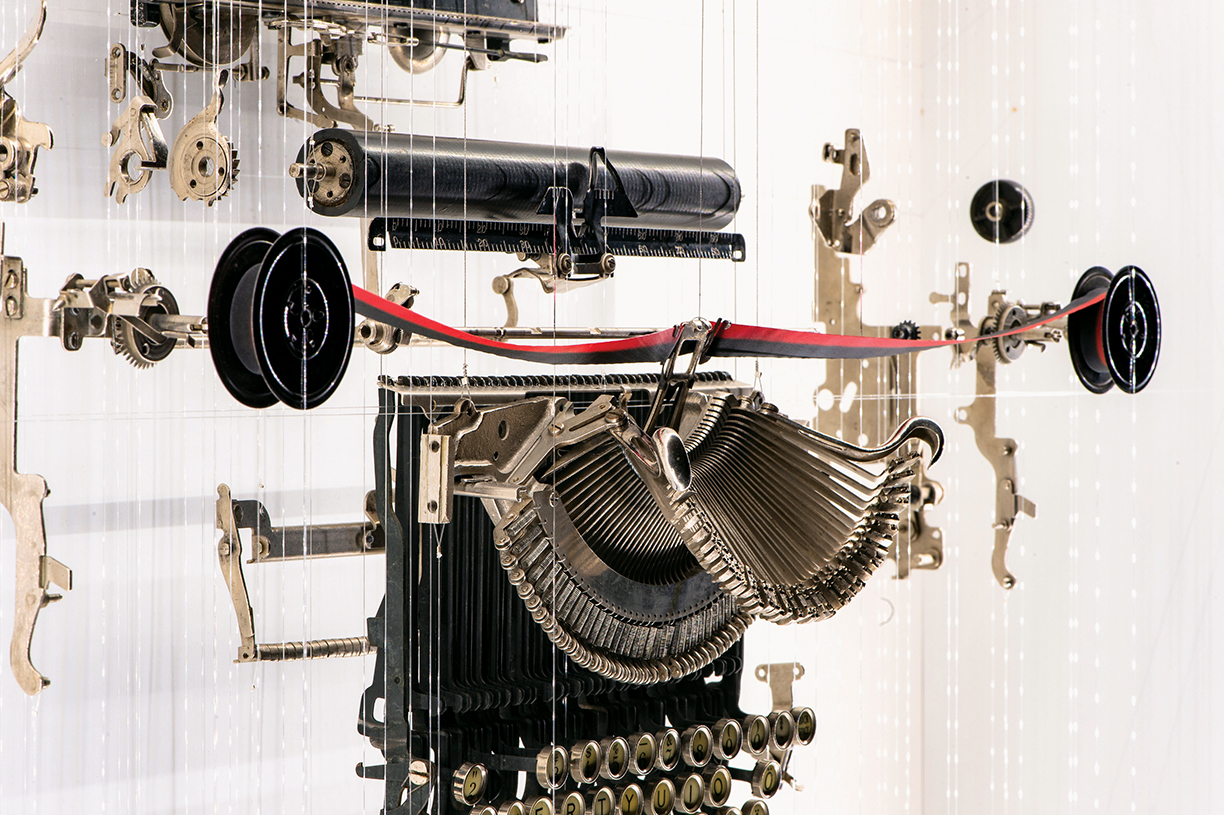
Peralta describes a large pile of items in his studio that he might one day choose to take apart, but there is a method to deciding which items he will display. “I usually choose something that would be considered iconic. Something highly recognizable, and familiar, but most of the time, it’s also something that is no longer in use,” he says. Often, he chooses items that people may have seen in their grandparents house or in an antique store. “Those items have a lot of emotion and nostalgia connected to them. I’m also looking for things that the designers and architects put a lot of time and careful thought into.”
“For some reason, it has a strong appeal. I’m not entirely sure why,” Peralta says about the exploded diagram concept, explaining that most people see them in their everyday lives without realizing, but their eyes still light up when they see it displayed like this. “Because it’s not like you can’t see the string. At first, I tried to hide it. I tried all different things to try and hide the suspension. But I began to realize that I actually shouldn’t hide it. The string really contributes to the piece.”
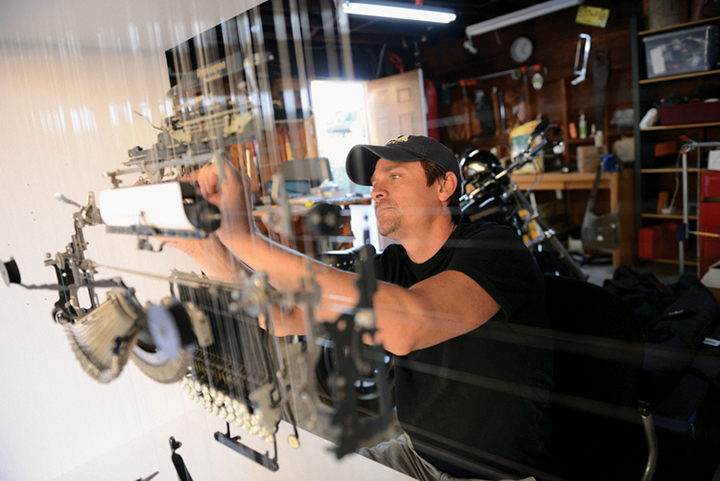
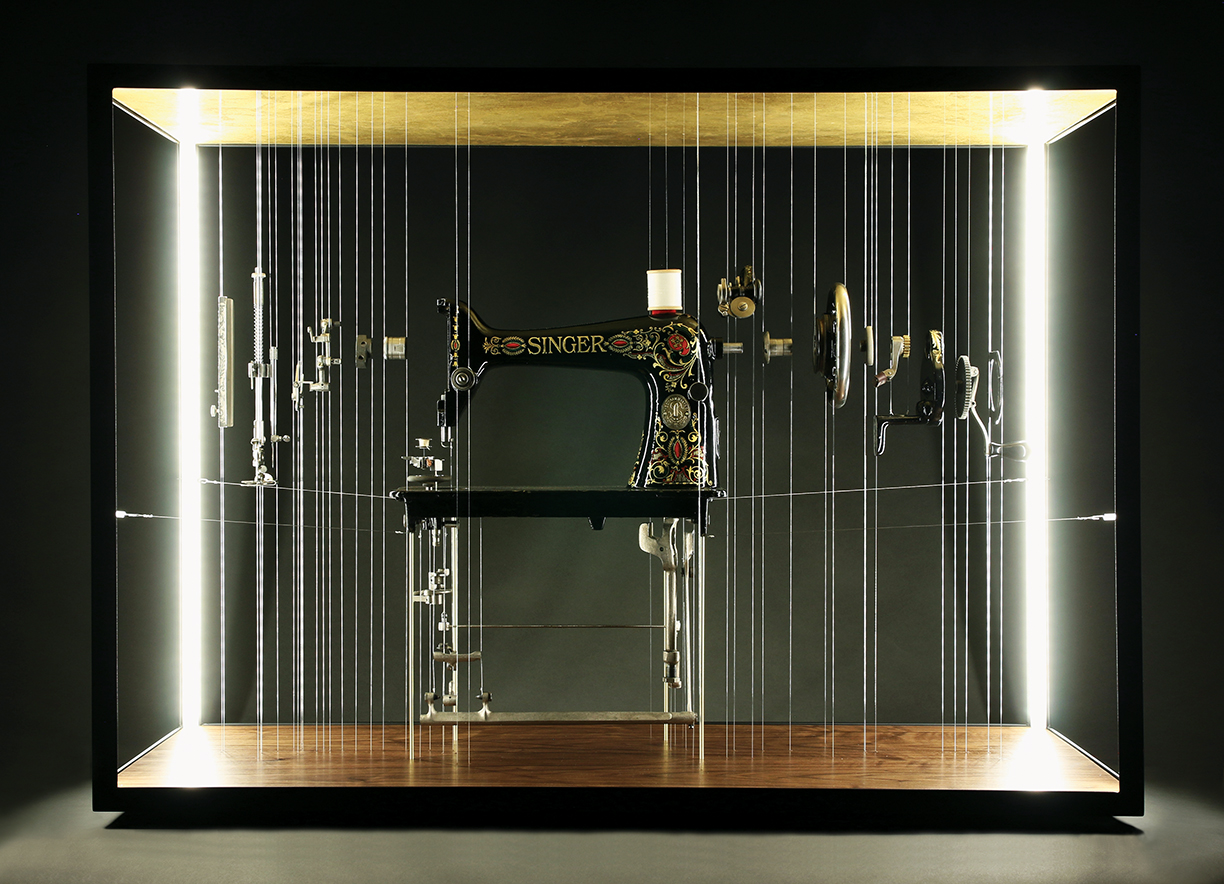
In the Future
Working mainly on commissioned pieces these days, Peralta is still working on a few ideas that continue to push the boundaries of the exploded diagram concept. When asked what his dream projects are, he says, “There’s actually two. I’ve been wanting to do — and I haven’t really gotten anyone to pull the trigger yet — and that’s a grand piano. I think it would be very impressive. I imagine it in a large hotel with a high ceiling or something like that. And the other one is a fighter jet, which would obviously be a very big piece. It would need a superstructure to support it. But I have some really cool ideas of how it would look.”
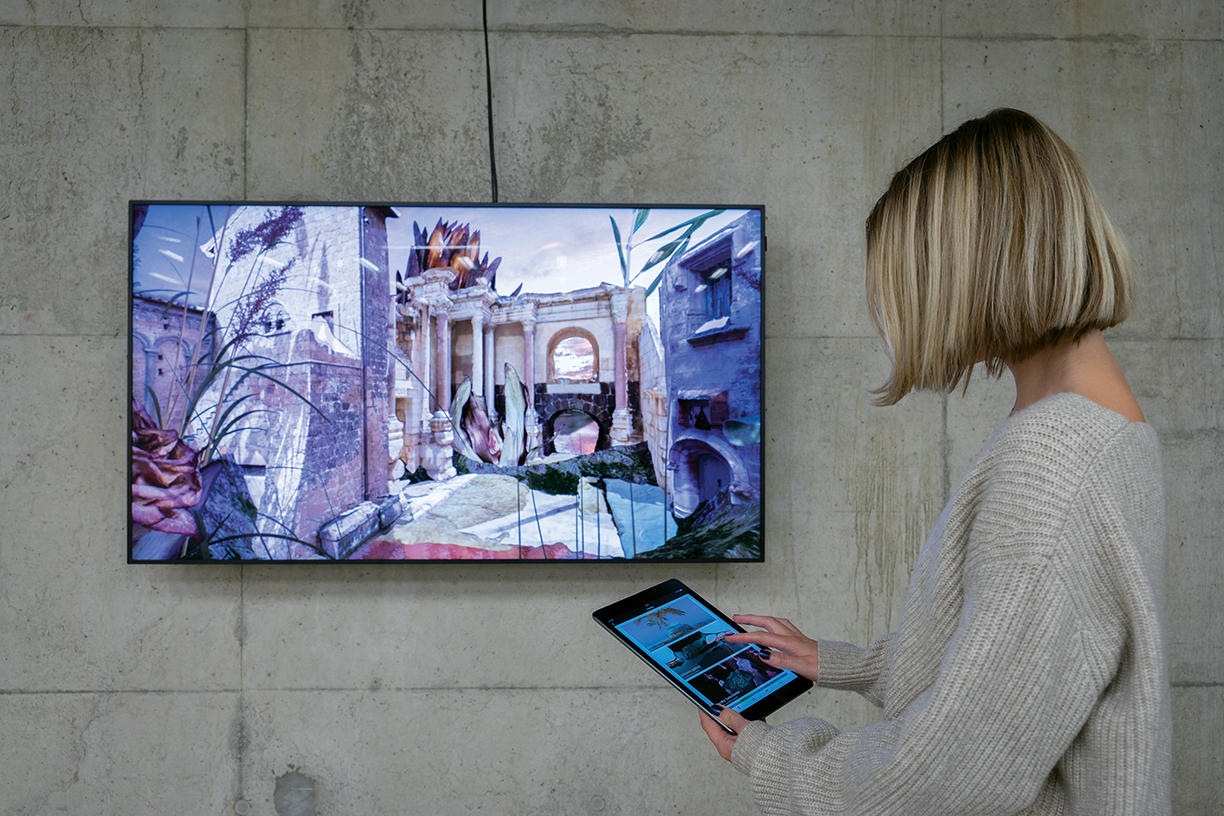
Photo courtesy Niio.
Smart technologies and artificial intelligence are changing the way we consume art.
While many treasured works of art are safely contained in notable museums or in the homes of experienced collectors, a new tide is cresting along the shores of the art curation field with the influx of digital art.
Digital art, more widely known as new media art, is an interesting sector of the art industry to define, even for Beryl Graham, who is a professor in New Media Art at the University of Sunderland. She notes that the roots of this art form have drawn inspiration from a range of movements, from conceptual artwork to video art, which also began in the 1960s.
“It’s broadly digital but [it’s also] the kind of art that works in different ways in different kinds of behaviors,” Graham notes. One fascinating example would be an exhibition of software art in which the software, sometimes even artificial intelligence-based artwork, can learn and grow on its own. Graham explains that an artist might start a piece of software and watch it evolve, perhaps give it a virus and watch, showing to the audience that the “end point isn’t quite under the control of the artist.”
Magdalena “Magda” Sawon, owner of the contemporary art gallery Postmasters Gallery in New York, says that the digital age has only heightened the senses of curators and artists, who are traditionally at the forefront of new developments in culture and technology.
“Technology is a tool,” she notes, “it is also a moving target and changing constantly. The question is to be aware of new developments and adapt it intelligently to one’s needs and benefit.” Fittingly, as artists have been harnessing the power of technology within the art industry, curators and galleries have had to “keep up with the times,” and embrace digital forms of artwork and the systems and methods in which they are displayed.
Donna Holford-Lovell, director of The North East of North festival (NEoN), notes how the incorporation of interaction and participation into art displays appeals to today’s technology-savvy audiences that have been gradually reinvigorating focus on the digital art world.
“The idea of ‘curation’ has become ubiquitous and our audience is seen to be curating many aspects of their own lives,” Holford-Lovell says. NEoN is an organized event that aims to advance the understanding and accessibility of digital and technology-driven art forms by having the artist and curator work together to translate “the spectacle of experience,” via digital platforms within physical spaces, like virtual reality, artificial intelligence, and even social media.
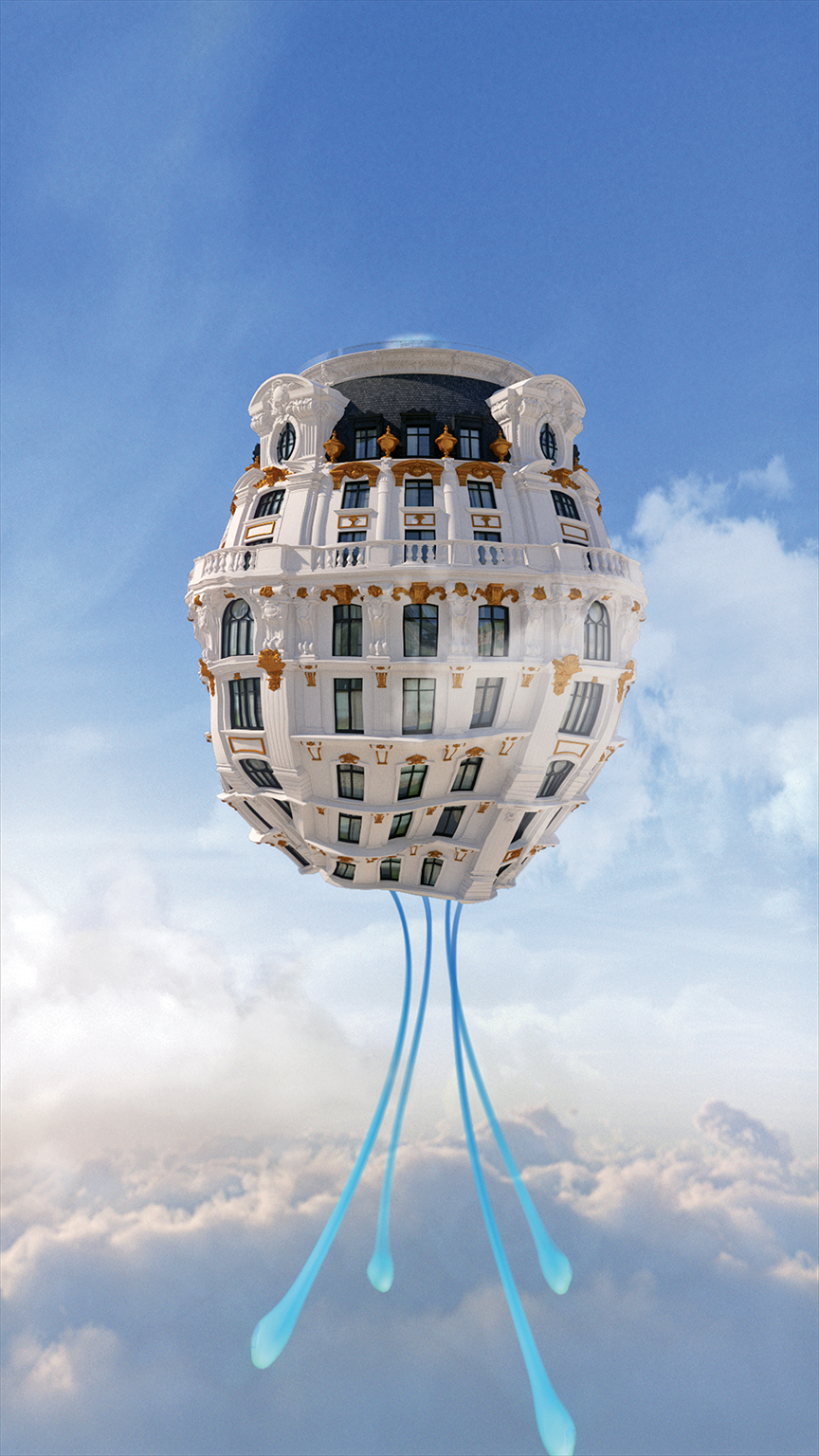
JONATHAN MONAGHAN (US)
The Phoenix and the Medusa (2018), Video, 7 min 69 sec, Edition of 30, Niio Commission Series.
With systems and platforms, from artificial intelligence to online-based forums, both artists and curators now are developing larger platforms and databases to contribute toward. As well as an educator, Graham is co-founder and editor of the Curatorial Resource for Upstart Media Bliss, or CRUMB, a resource for curators of new media art that aims to help overcome any challenges presented from this rise in digital art, from installations to networks of artists and individuals versed in these practices.
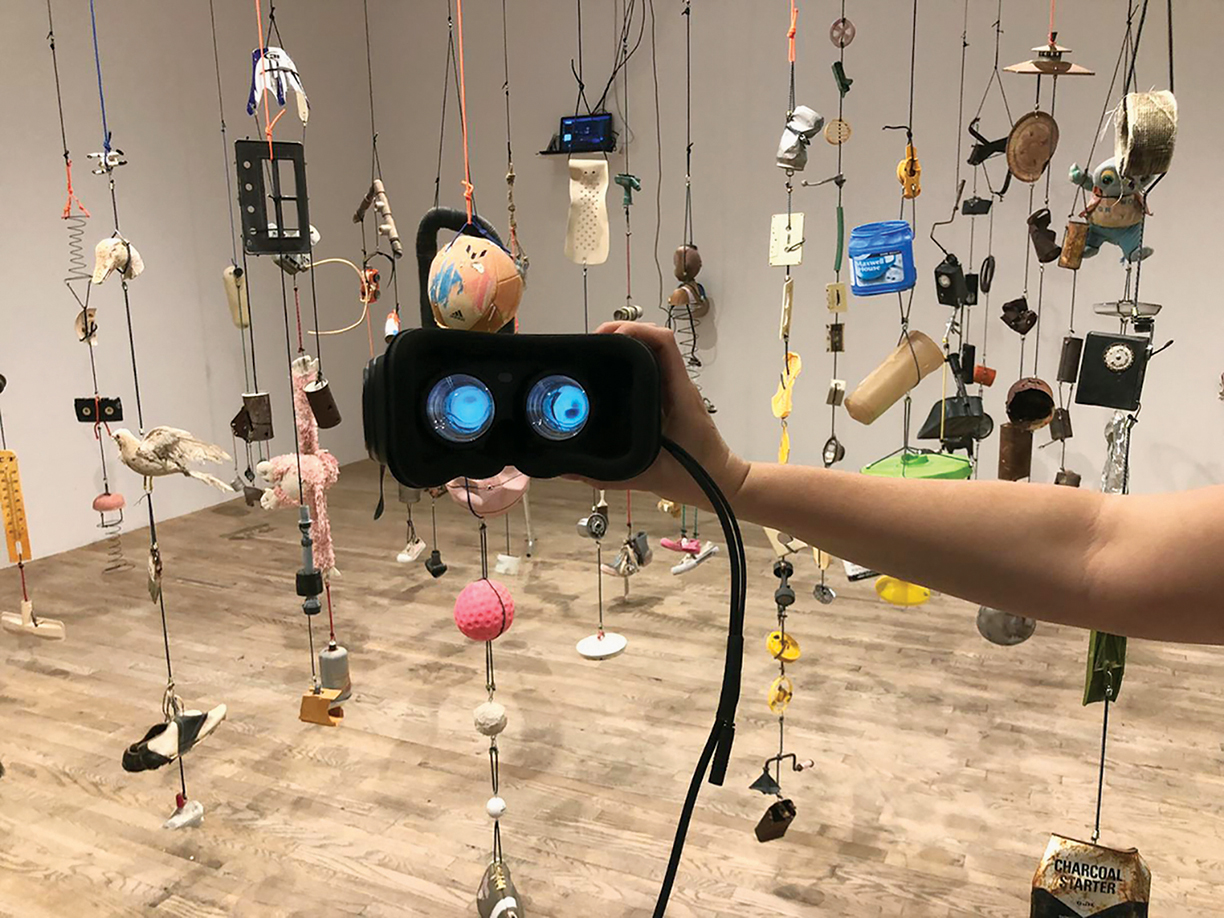
PERRY HOBERMAN
Suspensions (2018), VR and mixed reality installation, Postmasters April 2018.
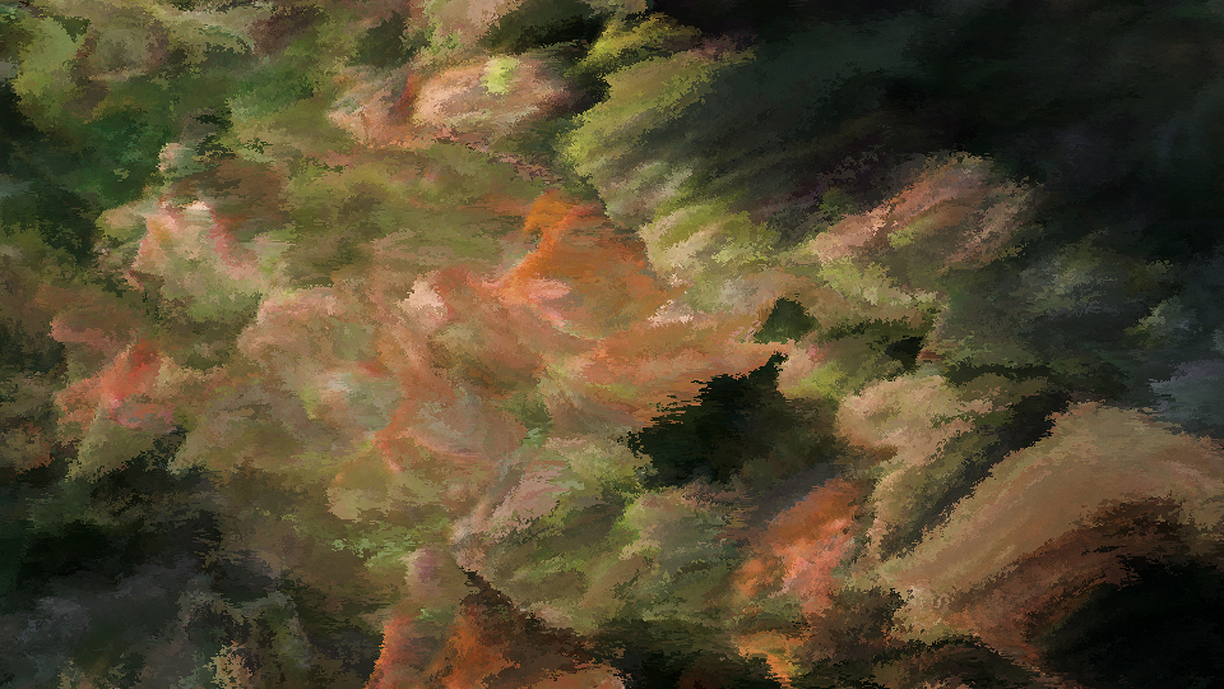
QUAYOLA (UK)
Camouflage (2018), Moving Image, 6 min 4 sec, Edition of 30, Niio Commission Series
On the luxury spectrum of art curation, Niio is a brand integrating digital art and technology-driven forms of collection and distribution that surges past the limitations of traditional artwork. Niio is an art and tech company aimed to enable the exposure of digital artwork in a time that to the company feels like a fourth industrial revolution.
“Art has always reflected the world we live in,” says Rob Anders, CEO and co-founder of Niio, “and artists will create their art with any tool they can access.” In today’s world, that tool has come to be technology. Anders, who understands the eclectic background of digital art from conceptual and video art, wanted to help designers and architects best fit homes with the art of today, and after speaking with top galleries he found that what’s really needed are new models of both the business and technological side that reach a broader audience — even better: one with a subscription.
“We envision a world where in homes people will have more digital canvases with interactive or immersive works, all on a centralized connected system that can very easily change,” Anders says, with access to top artists in the world in this ecosystem of artists, galleries and collections all on the Niio platform. Luckily, the CEO notes, the technology is “already there,” from artificial intelligence in devices like Amazon’s Alexa devices to smart televisions, all devices that can easily work with the Niio platform to display digital artwork.
To those interested in having access to the “world’s finest art accessible on-demand,” Niio is open as a limited edition membership at about $5,000 a month, with access to curated exhibitions and collections, or art “playlists” of over 7,500 art pieces on the platform that can be easily changed and displayed on devices like smart TVs, projectors, screens, et cetera, which can be installed by Niio technicians as well.
“Art curation is telling a particular story,” he says. “In order to give people these digital works, it’s not about just finding the individual works, it’s about giving people the ability to learn about the works they are looking at,” he says.
Artist Concetta Antico sees the world in 100 million colors.
Concetta Antico sits down for lunch at a local cafe, after settling on smoked salmon and a strawberry salad. Before eating, she takes a moment to acknowledge the array of color in front of her: the blue-violet of the salmon, the thousands of reds bouncing around the strawberry and the light turquoise surrounding the seeds. “I promise you, I am not high!” she says, “I just truly see what I am looking at.”

Super Vision Mutation 12 X 16

Persephones Peacock in the Garden of Paradise 8 X 36
Better known as “The Color Queen,” Antico sees pinks, blues and violets in the green grass, an array of colors glistening off the white snow, and hundreds upon hundreds of colors within a rainbow. And they’re not just a figment of her imagination: her rare, genetic gift of heightened sight allows her to see almost 100 million more colors than what meets the average human eye.
In addition to being an artist, teacher, and color consultant, Antico is what scientists call a “tetrachromat,” meaning Antico’s eyes contain a rare genotype that provides a fourth receptor as opposed to the usual three, more common in women than men. With this, Antico’s tetrachromatic potential reaches up to 100 million colors, 10 times more than the average 1 million.
For now, Antico is the only authenticated tetrachromat artist on Earth, with 1,000 internationally acclaimed pieces of art and features in Reader’s Digest, Vogue, New York Magazine, and more.
Antico is originally from Australia, and was drawn toward art and color at a very young age. At age 8, her mother recognized her potential to become a famous artist, constantly showing support for Antico’s art. At age 16, she left home to cope with her mother’s passing, winding up in Los Angeles.
“I am a bit of an adventurer,” she says, “Sydney got too small for me. I was heading to work in Canada, I stopped in L.A., and it entranced me.”
Despite her hardships, she always kept her deep passion for art at the forefront of her life and career. Antico knew she was meant to paint professionally, and so she began teaching in San Diego, ultimately instructing 25,000 budding artists in oil painting.
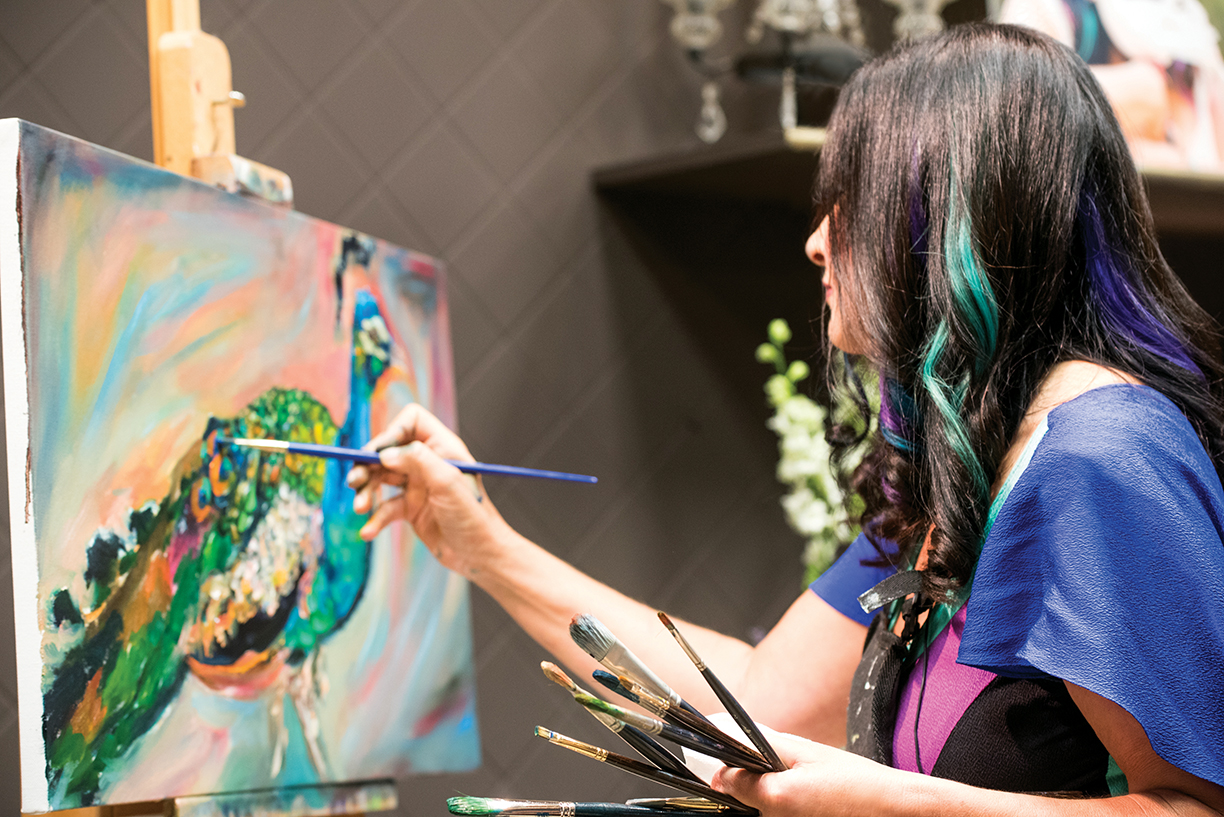
Artist Concetta Antico works on a piece named Iridescent Eyes… Charlie The Peacock 18 X 36
“Oil painting makes you healthier, and if we surround ourselves with beauty and happy spirits, we will be in a constant state of color euphoria.”
While teaching, Antico would point out the colors she sees in everyday objects and receive mixed reactions from her students. She says, “My students would tell me, ‘We don’t see that color that you see!’ I’d be confused, but then I educated my students to see a little more color.”
It wasn’t until a buyer of Antico’s, who happened to be a scientist, realized Antico could be a tetrachromat. Then, she began to understand her ability to see millions of colors. “I always thought I was different and unique,” says Antico. “The way I do things, what compels me, the way I painted … I didn’t realize that I could see and create colors like a computer.”
In late 2012, Antico was evaluated both genetically and behaviorally by Jay Neitz, Ph.D., a world-renowned leader in color vision. She soon discovered she was in fact a tetrachromat, and possessed an incredible genetic gift that affects only 2 to 3 percent of the world’s population.
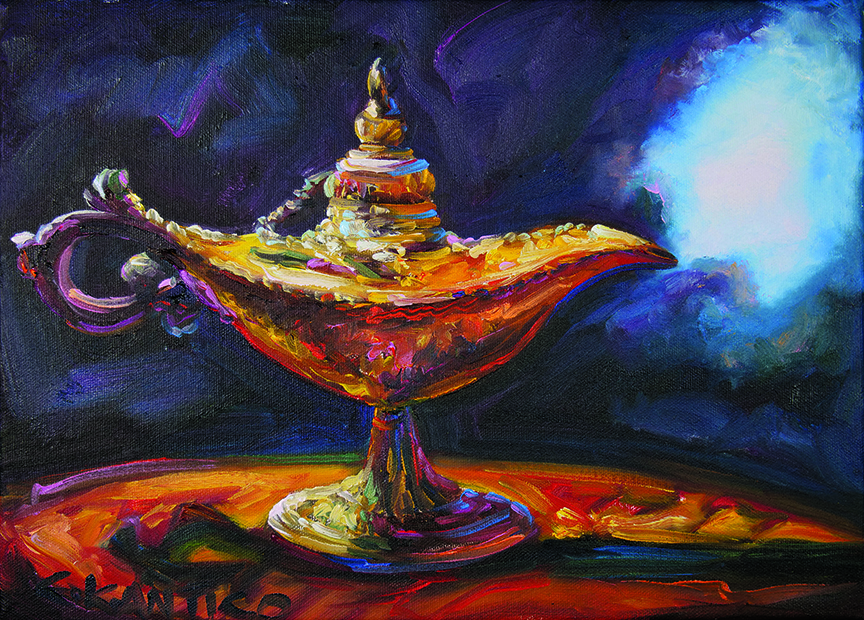
Who’s Your Genie 10 X 14
“It was just another part of the uniqueness of Concetta,” she says. “The gift is made up of my mother, her vision for me, how she put red and blue lights in the swimming pool to make lilac light, my high school that was big on art, my genetics, my brain, and my own passion, ambition and drive.”
Today, Antico wants to use her gift to make the world a better place, truly treasuring the world around her. In an interview with Stanford University, Antico said that, “enhanced color created enhanced joy.” She is constantly happy and joyful, happy to wake up and see trees and sun.
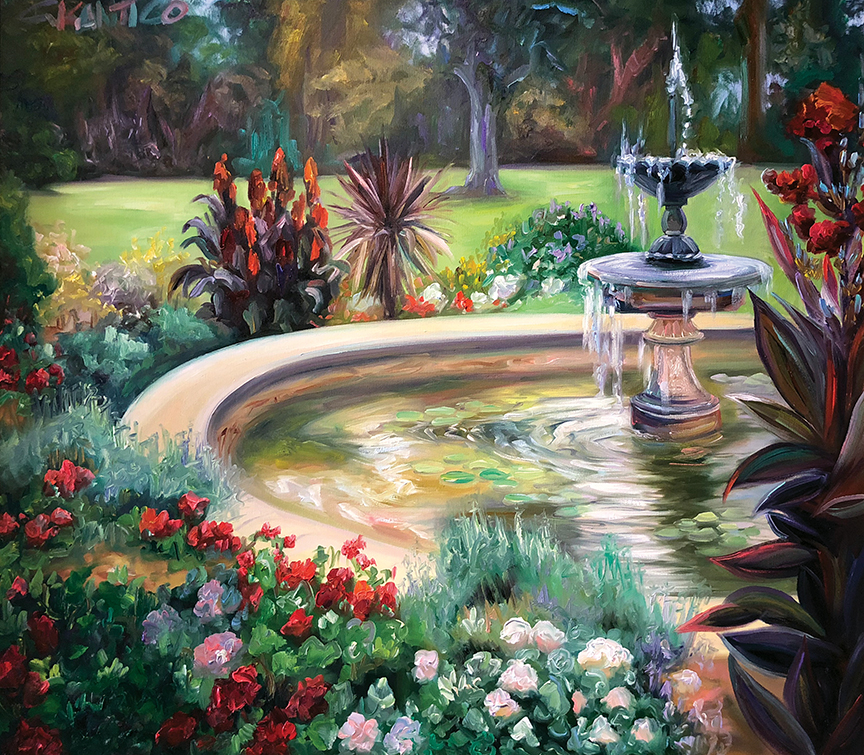
Reflecting Pool of Narcissistic Love-Vaucluse House-Sydney 30 X 36

“Oil painting makes you healthier, and if we surround ourselves with beauty and happy spirits, we will be in a constant state of color euphoria,” she says. “My gift makes me so excited to paint, look, share. Color has made me joyful, and has only enhanced my life. There are no disadvantages to beauty and color.”
Antico has a wide range of muses, as she aims to paint whatever captivates and moves her. Her paintings are divided into two categories: “earthly delights,” which encompasses everything on earth that she paints, and “otherworldly wonders,” which includes galaxies, magic and more. She often leans toward the ethereal subjects such as mystic skies and otherworldly galaxies. “Not people, though. We’re just not that attractive,” she jokes.
For those with normal sight, a place like a grocery store or a highway are simply as they seem. But for Antico, she is able to see past the veil and see further into the typical. “I’m captivated with the sky and trees beyond the freeway. I’m hyper-focused on beauty around me.” Sunsets, for example, are a religious experience for Antico, with the amount of splendor and color that they produce. “I am very blessed. I wake up every day and am so elated to see what I see and do what I do,” she says.
One of Antico’s main beliefs is that everyone has gifts, not just her, and that they should all be used to better our world. “Media can be dark, and we need light,” she says. “I want to use my platform for that. I have a place as ‘The Color Queen,’ and I feel that I can make people see their worlds differently.”

Conjuring Crystal Ball Colors 18 X 24
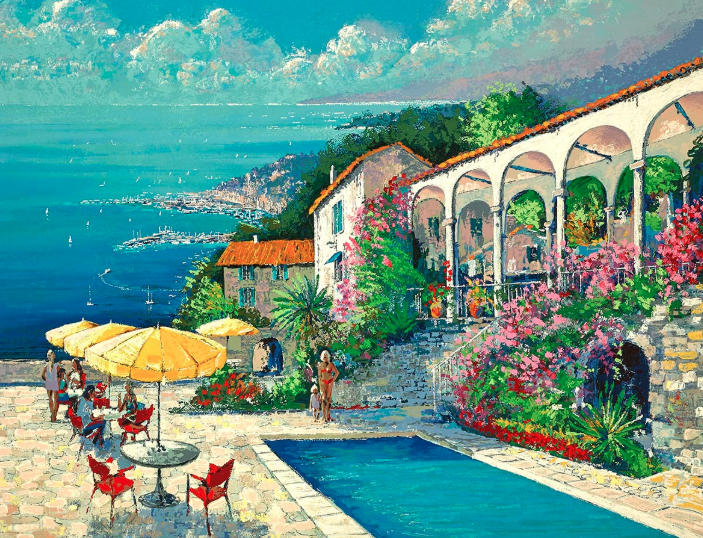
British artist Kerry Hallam captures the essence of luxury living in his bold, timeless paintings. Coastlines and nautical themes are present in many of Hallam’s works, invoking a tranquil mood pervasive in his depictions of shores, sunsets and wharfs.
Hallam, 81, has exclusively painted for Martin Lawrence Galleries — which is famous for its contemporary fine art exhibits that attract collectors to each of its nine locations nationwide — for more than 30 years. His works include acrylic paintings on canvas as well as on nautical charts, and hand-signed, limited edition graphics.
Earlier this year, Hallam presented two special exhibitions at Martin Lawrence’s La Jolla, California location. He participated in a meet-and-greet with art enthusiasts and collectors, encouraging them to relish life’s simple pleasures. Visitors embraced the opportunity to grow familiar with Hallam’s latest works and immerse themselves in the artist’s alluring paintings.
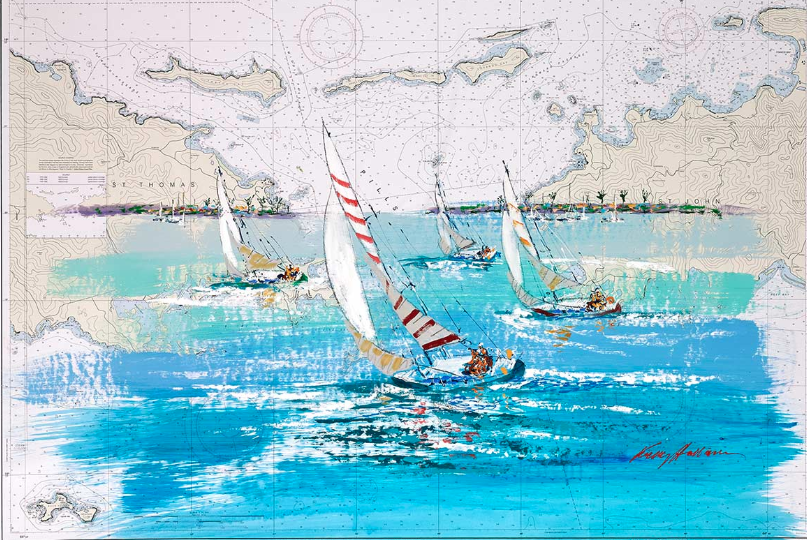
A lifelong traveler, Hallam draws inspiration from the aesthetics of St. Tropez, the French Riviera and the Amalfi Coast. While his acrylics on canvas showcase the raw beauty of coastlines around the globe, his nautical chart paintings offer a new perspective on sea-inspired artwork. By incorporating his inspiration into both the medium and the final product, Hallam sets himself apart from other nautical painters.
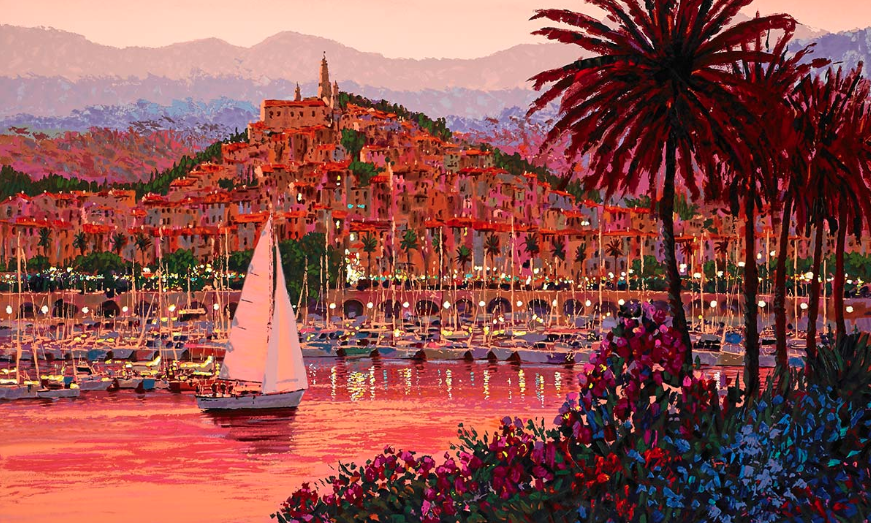
With bold, bright colors that captivate the observer, Hallam’s paintings are a refreshing take on what many artists would choose to keep muted and scaled back. Though his focus remains on the sea, Hallam includes vibrant vegetation and colorful man-made structures in his paintings of coastal scenes.
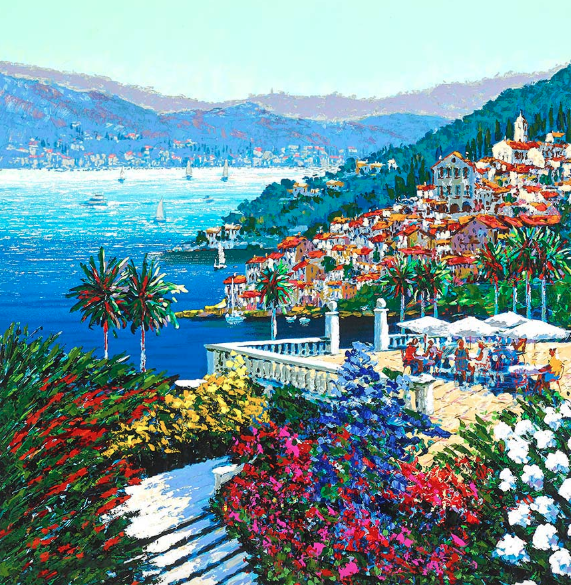
After receiving training from British master painters upon winning a six-year scholarship to London University’s Central College of Art, Hallam was also included in Britain’s Royal Society of Artists in Watercolor. The artist is also inspired by 19th-century French Post-Impressionists, as well as Cezanne and Van Gogh.
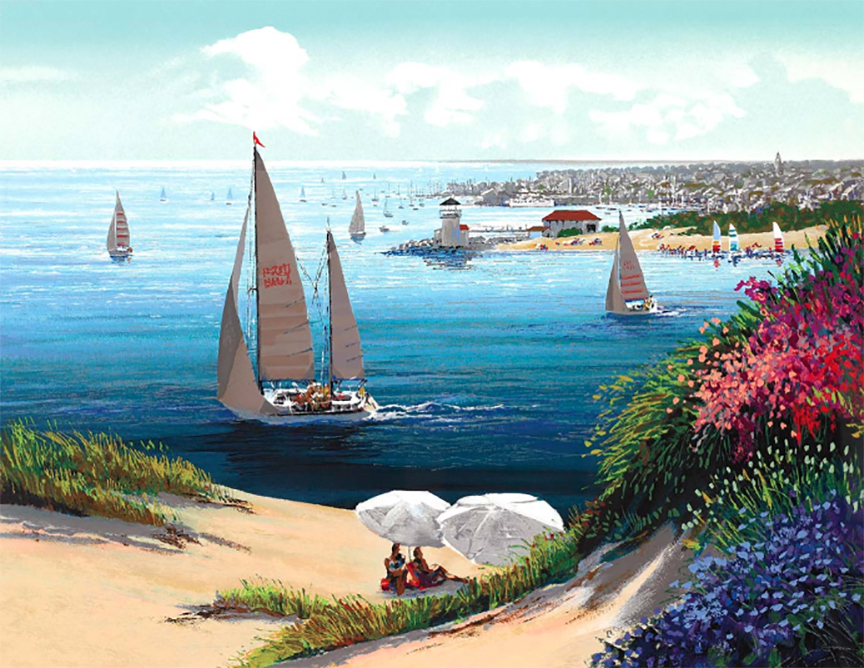
Hallam moved to the U.S. in 1973, and established his first studio in Boston. In 1981, he opened a studio and gallery on Nantucket Island — he has since lived in various places in the U.S., but made the decision to return to New England, where he currently resides.
Photos courtesy of Martin Lawrence Galleries.
Artist and inventor Bandana Jain works with recycled and eco-friendly materials to create one-of-a-kind artwork for the home.
Sharing a deep concern for the environment, the contemporary artist has been creating artwork using corrugated cardboard for the last seven years. She crafts unique furniture for clients — from couches and desks to tables and lamps.

She is also the founder of Sylvn Studio, a business dedicated to conserving the environment. The India-based business is the country’s only design label specialized in hand-crafted décor products made of recycled corrugated cardboard.
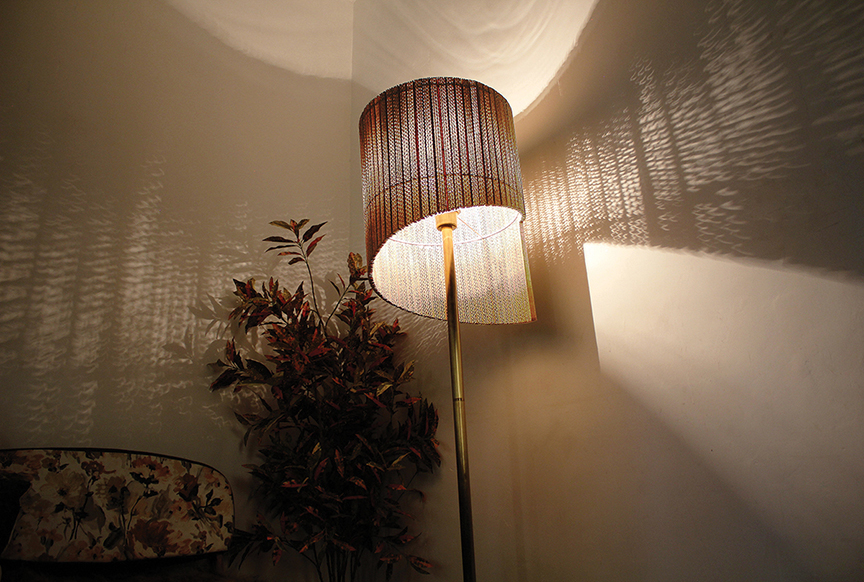
How did you first begin your work with cardboard? Why did you choose this medium?
Initially, I worked with a few other mediums. To choose cardboard as a signature medium was a conscious decision I had taken because I wanted to offer something different. Also I wanted to educate people about adopting sustainable lifestyle.
How has your journey with this medium shifted in the last seven years?
It only grew with time. Corrugated cardboard is certainly not an easy medium to work with. I struggled a lot and over time I gathered experience and maturity to handle this medium. I must say nobody can touch me now.
Why is it important that designers/artists use recycled and eco-friendly mediums and that homeowners choose to purchase these types of artwork?
We are all the children of the earth. The existence of our being is intrinsically connected to nature. As responsible humans, it is for us to ensure that we build a better place for ourselves and subsequent generations to come. This can happen only when we make the right choice.
Why should homeowners incorporate these pieces into their homes?
A well-designed interior accessory revs up the design quotient of your abode. And every accessory in a home is akin to an individual chapter in the overall design narrative. It defines the space and tends to be a conversation starter because of its exclusivity and aesthetics. Who doesn’t want to be talked about?
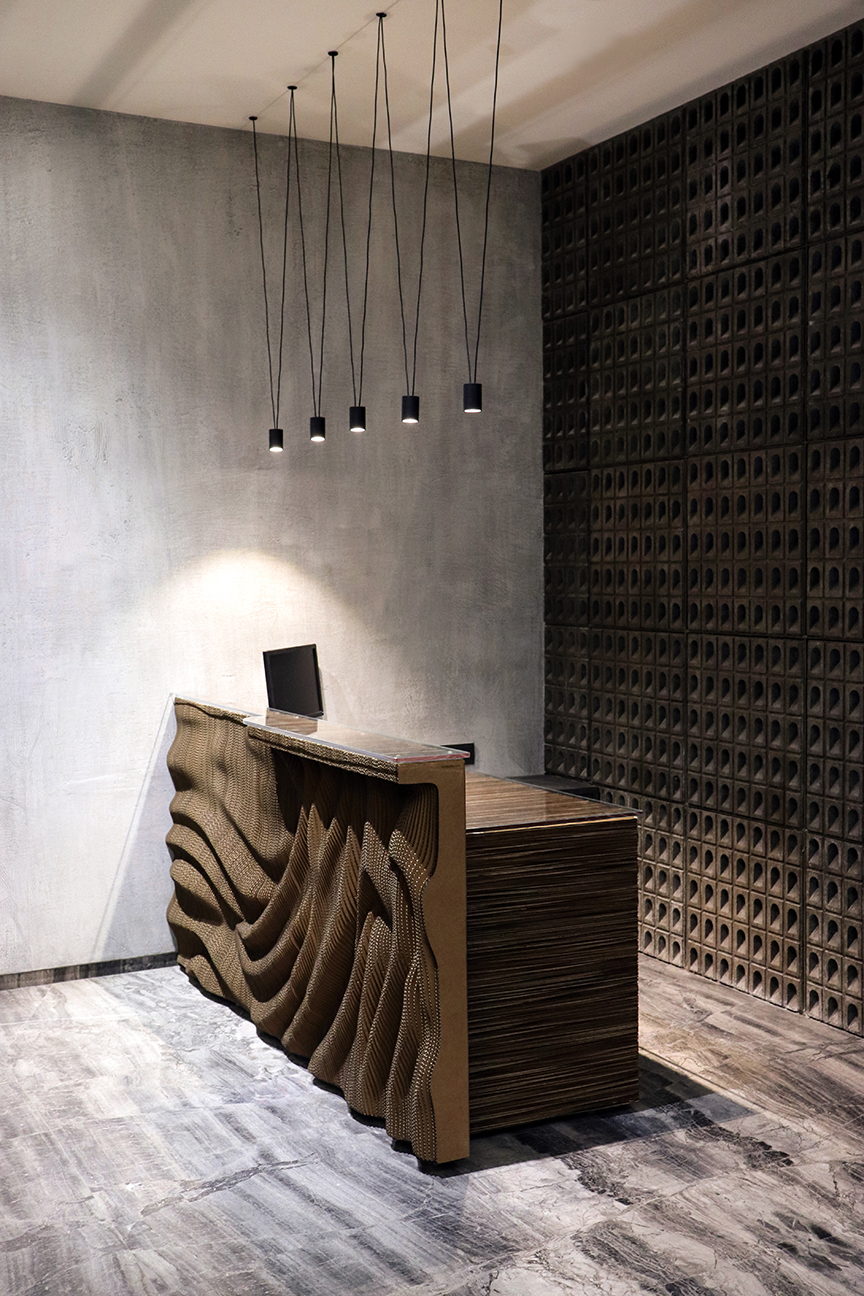
Where do you gather inspiration for your creations?
Inspiration comes to me from a myriad of spaces. As an artist, my observations and experiences guide me. My choice of medium is also a part of my experience. Once I was in Zermatt where I had the chance to explore the Eco Village; the determination of the locals to keep the town sustainable inspired me a great deal.
Photos courtesy of Bandana Jain
Martin Lawrence Galleries recently announced that the latest works from pop-illusionist Philippe Bertho — which showcase his recent decision to explore the dreamlike deliriums and the vibrant pleasure of his own personal narrative, context and texture — will be exhibited at its SoHo location.
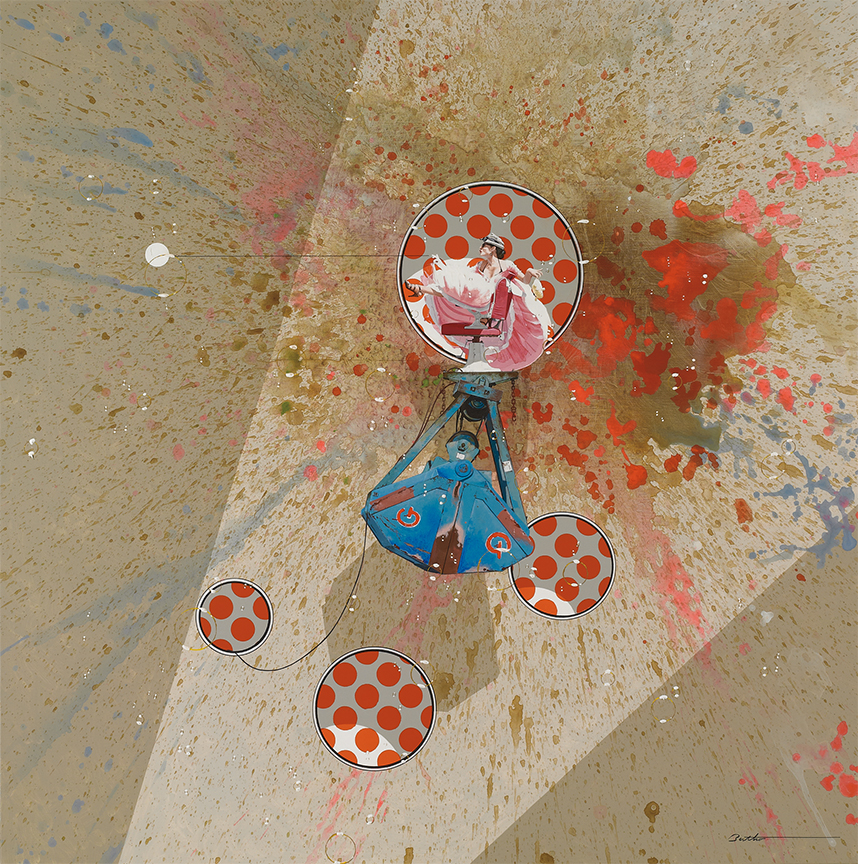
Philippe Bertho, Gruetesque, acrylic on canvas, 47 1/2 x 47 1/2 inches
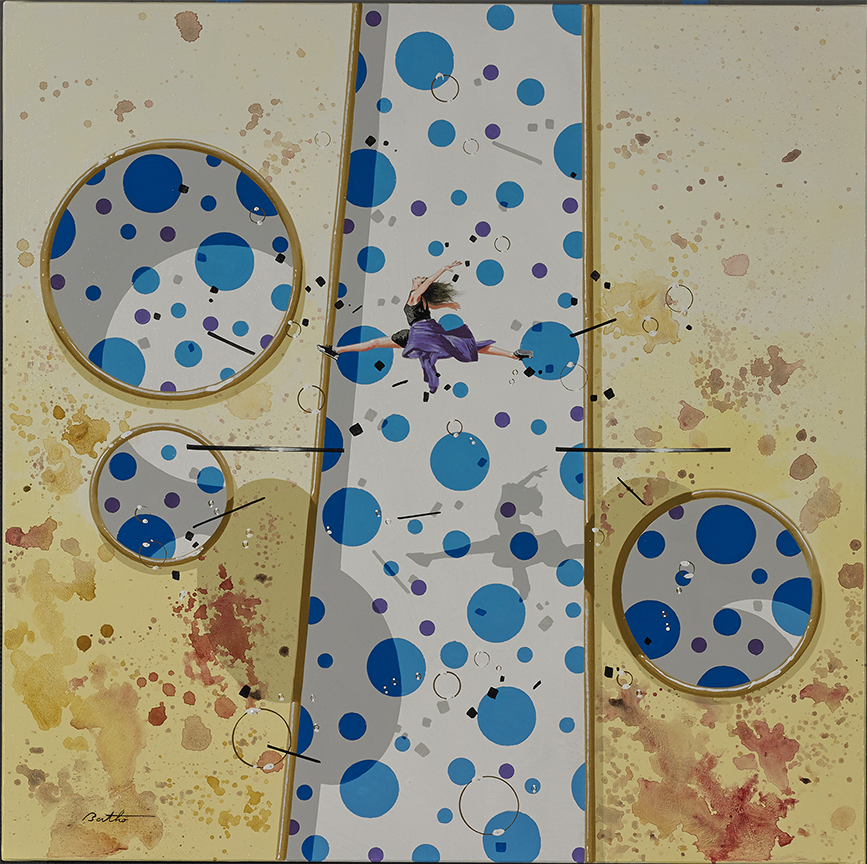
Philippe Bertho, Le Grand Saut, acrylic on canvas, 23 1/2 x 23 1/2 inches
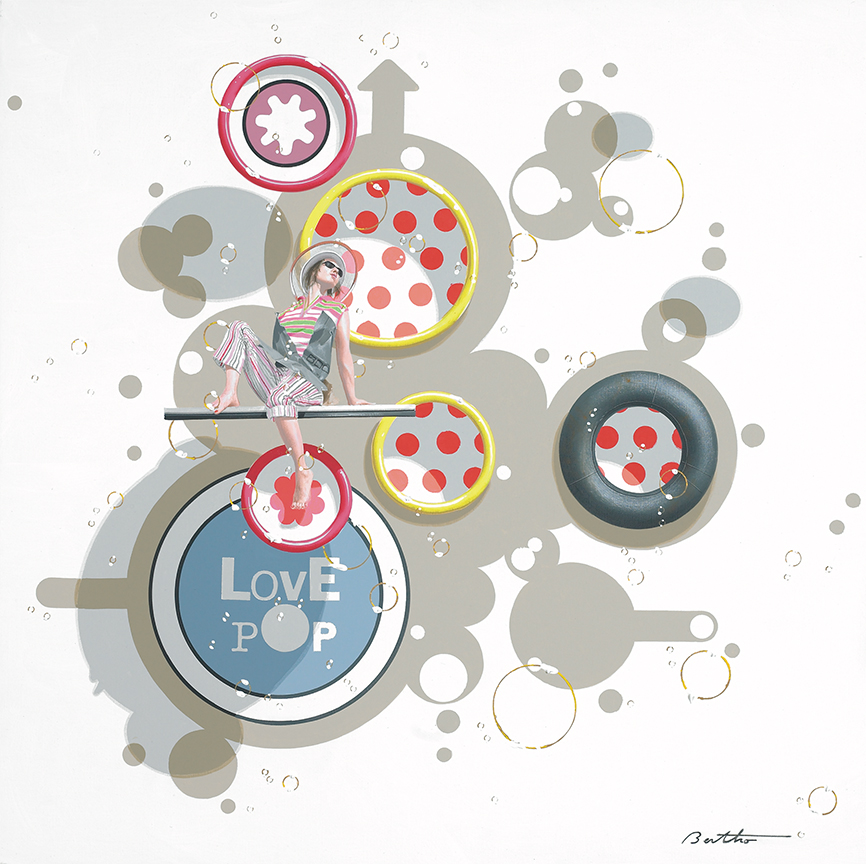
Philippe Bertho, Love Pop 3, hand-signed serigraph on linen, 24 x 24 inches
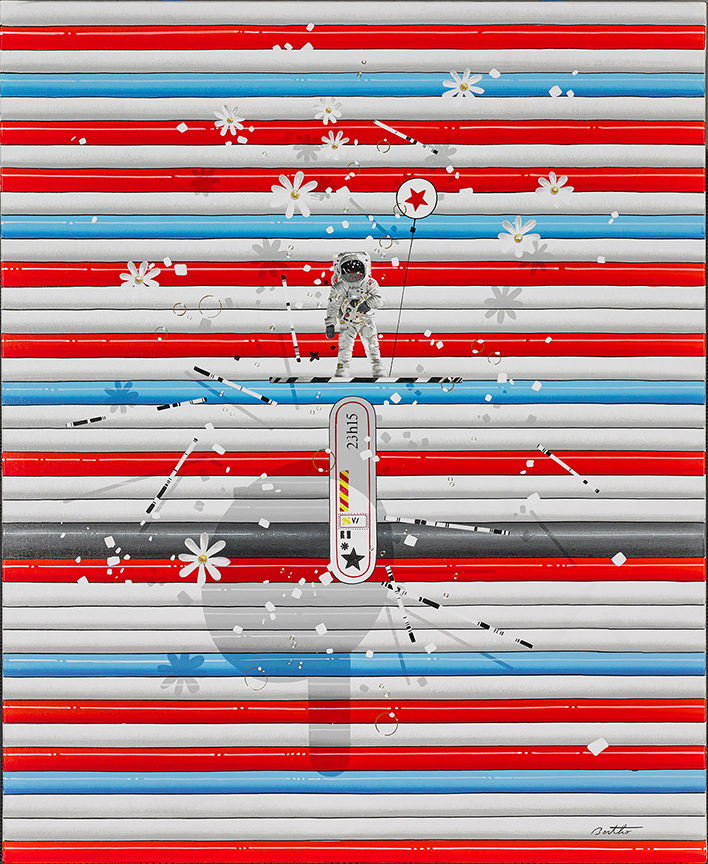
Philippe Bertho, Le Plus Beau Cosmonaute, acrylic on canvas, 28 3/4 x 23 1/2 inches
MLG began presenting the unique works of Philippe Bertho exclusively at its nine galleries across the country a decade ago, noting that never before had it seen a painter of such magnificent vision and unique perspective. Since then, Bertho’s work is exclusively offered at its fine art galleries from New York to Orleans to Maui to La Jolla. MLG notes that Bertho’s personal and visual works illustrate, enlighten and — with gloriously subtle nuance — confound the eye.
“I think my paintings are paintings of ideas. There are many kinds of painters; I am a painter of ideas who paints with delicacy and restraint,” says Bertho. Bertho, born in the Brittany of France, is a classically trained artist who began studying his craft in the early 1990s in Reims. He spent considerable time mastering trompe l’oeil (“to fool the eye”) painting, a technique which literally creates the illusion of a third dimension on a flat surface.
“For a long time, I naively believed that painting was a matter of technique. Then I read about Picasso, son of a drawing teacher, who spent his life learning to draw as a child; then and there, my perspective on art was transformed forever. To represent a face in profile and from the front at the same time; it is simply great poetry,” says Bertho.
Bertho’s newest works, now offered for acquisition at MLG’s SoHo, New York and San Francisco locations, reflect his desire and recent decision to return to his vision of life as new ideas. New and original works on canvas and hand-signed prints are available to view and acquire.
Kaplan brings color and life to her fragile masterpieces, taking high tea to new heights.
By Roger Grody
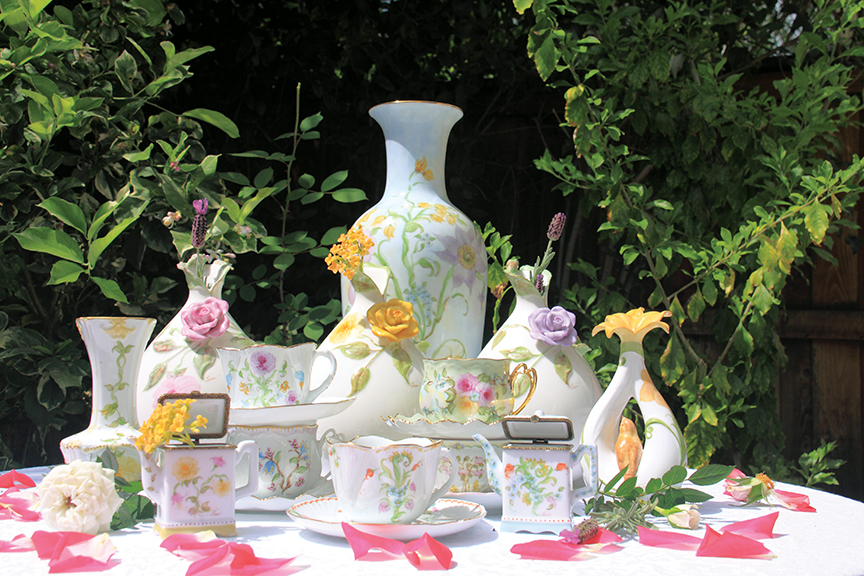
Photos by Lindsey Baumsteiger
While most painters work with canvases, some apply their skills to wood or metal and others, sometimes controversially, transform buildings. Artist Lissi Kaplan’s work is preserved on fragile porcelain, often contemplated over tea service in opulent salons. She is one of the premier porcelain painters in America and her work is coveted by collectors and exclusive hotels.
Born into an artistic family, Los Angeles-based Kaplan was once an aspiring opera singer who studied voice in college but eventually embraced her creative spirit as an interior designer. With the passing of her mother in 1997, however, she found herself searching for a more personal form of expression, and when she discovered the porcelain collection her mother left her, she knew she had inherited much more than just table settings.
When Kaplan began painting, it was not only therapeutic during a period when she needed healing, but was also a tribute to her late mother. “I had so many memories of sipping tea with her, so I was happy to be able to create artwork around that ritual,” says Kaplan, explaining that her mom was her first voice coach and they would warm up their vocal chords over cups of tea.
“That art form spoke to me… a little painting under glaze forever. I was attracted to porcelain painting because it’s functional art and an heirloom that can be passed from generation to generation,” explains Kaplan. “There’s something about applying a brush to that smooth surface that is very soothing to the spirit.… You almost become one with the porcelain,” says Kaplan, who notes the use of fire adds another layer of magic to the process.

Artist Lissi Kaplan
(Photo by Steve Reisch)
Kaplan has been in constant demand for two decades, commissioned by a wide range of celebrities and institutions. She created a collection for the Ronald Reagan Presidential Library, but her bipartisan career also included an exquisite set of porcelain designed for Hillary Clinton. Kaplan prepared hand-painted gifts — porcelain emblazoned with poppies, the State Flower — for visiting dignitaries to California Governor Gray Davis, and her work can be found in the collections of Deepak Chopra, Tony Blair and Madeleine Albright.
When creating tableware for individuals, Kaplan’s artistic approach is informed by personal characteristics observed through one-on-one interactions. The bold colors used for Secretary Clinton reflect her strong personality and convictions, while Mrs. Reagan’s collection features softer tones expressed through peonies, a flower beloved by the late First Lady. Kaplan continues to be commissioned by clients seeking table settings with family crests or initials incorporated into ornate designs. In the vanishing art of porcelain painting, a five-piece set can take four months to produce.
Nature has always been one of Kaplan’s greatest inspirations, but the flowers and butterflies that populate her table settings are not precise scientific representations. “I think my work resonates with people because the designs are more whimsical and ethereal,” explains Kaplan, who suggests that like Chinese brush painting, her art is more about the spirit than science.
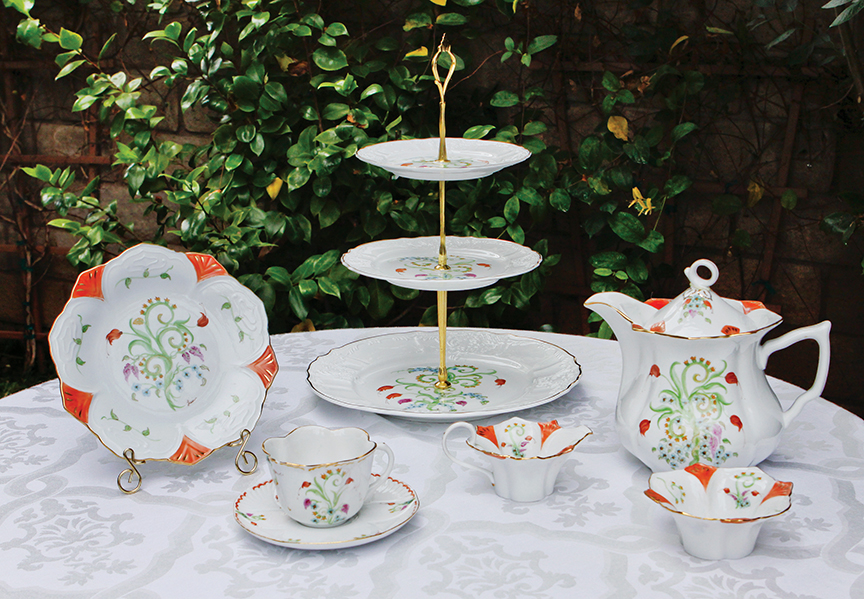
An exquisite hand-painted California wildflower collection elevates the elegance of tea service.
Roses, which Kaplan reports are among the most technically challenging images to create on porcelain, appear on a fluted dessert plate with 24-karat gold accents, an ornate Limoges tea table or even a whimsical hand-painted piggy bank that makes a unique baby shower gift. Images of tiger orchids create a dramatic effect and a leopard skin pattern appearing on vases and tea sets is created with gold leaf. Kaplan says this design, originally produced for actress Fran Drescher, is particularly labor-intensive as each of five separate layers of painting must be fired in the kiln separately.
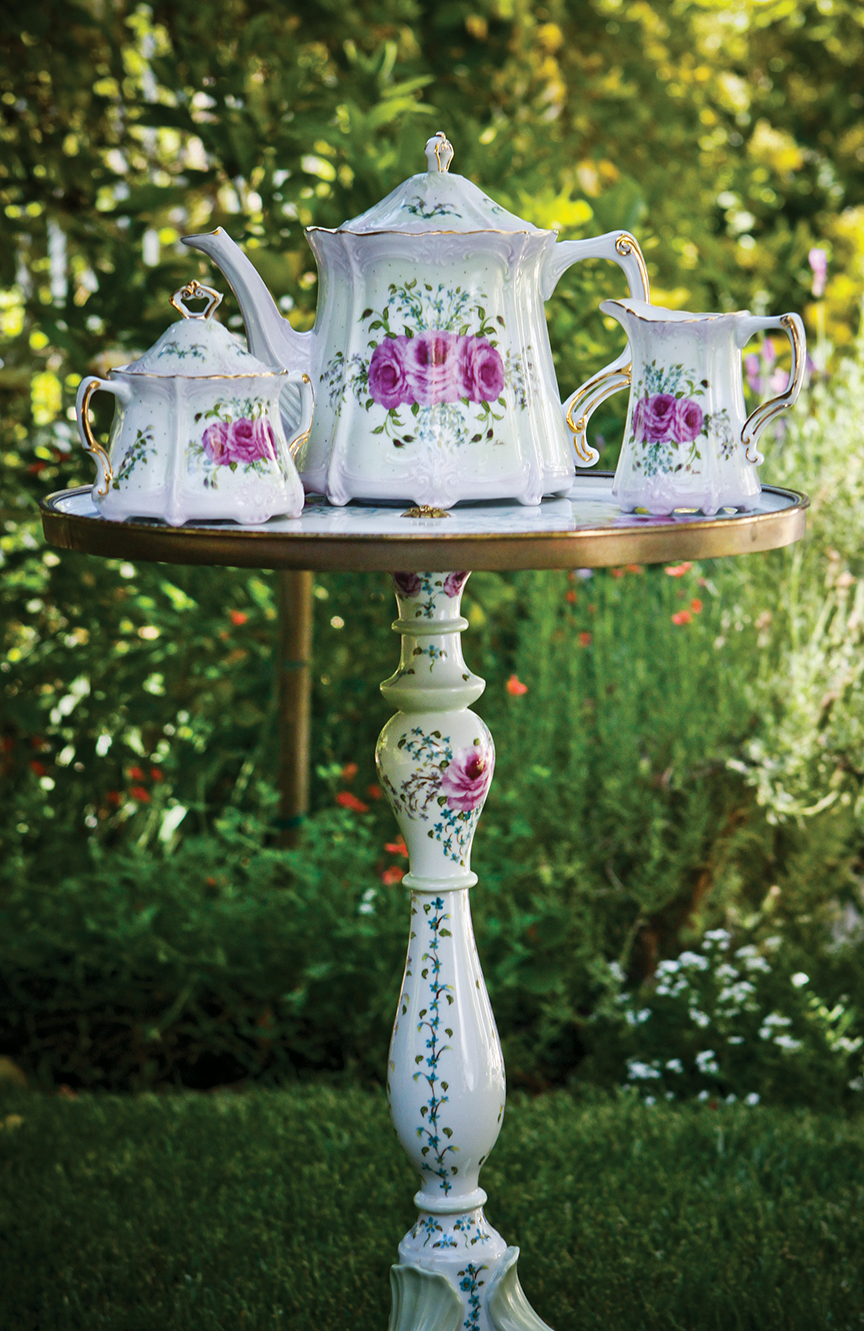
Kaplan applies her art to a three-piece tea set with matching Limoges tea table.
Grand hotels are among Kaplan’s biggest patrons and she was recently commissioned to create a new silver-laced tea collection commemorating the 25th anniversary of The Peninsula Beverly Hills. Other hotels that have served high tea on Kaplan-designed porcelain include The Montage in Beverly Hills and Santa Barbara’s El Encanto resort. Today, many renowned hotels opt for mass-produced porcelain, concerned with breakage of the more precious handcrafted items.
Kaplan’s first book deal was the direct result of tea service at The Peninsula, when influential literary editor Judith
Regan admired the hotel’s porcelain, part of a 600-piece original collection Kaplan created for the Beverly Hills hotel. “She looked at my teacups and said, ‘This artwork is speaking to me’,” reports the artist, whose book The Power of a Teacup (William Morrow, 2003) is personal and heartfelt.
In an era when many of the world’s porcelain manufacturers make concessions to mass production — even some producers in the revered village of Limoges, France’s capital of artisanal porcelain, now use decals — hand-painted porcelain is truly appreciated. Artists like Kaplan are increasingly rare and their work viewed as exquisite treasures.
Kaplan is moving into new territories, with her delicate brushwork appearing on textiles and wallpaper. Her most recent book Light as a Feather (Little Finch Press, 2016) is an endearing coming-of-age fable whose illustrations create a world of Kaplan’s signature pastel etherealness. If the pages look like they were lifted from an opulent tea room, it is because they were, in a sense. Each image was painted onto a porcelain tile, the medium this artist has mastered with great intimacy, then transferred to paper for publication. “When you put your heart into anything you love, it will be felt by others,” says Kaplan, an alchemist and dreamer whose passion elevates a cup of tea.
Contact: Lissi Kaplan
lissikaplan.com | 818.517.5293
Coined the “Artist Cottage,” this cute cottage is the home of the 2017 Palmetto Bluff Artist in Residence program, which welcomes a different artisan each month of the year for 2-week residencies.
This 1,955-square-foot cottage is situated in Palmetto Bluff’s second village, Moreland, and was designed with a fresh take on the Lowcountry architectural aesthetic — creating rooms that are inviting, interesting, inspiring and unpretentious. Shoreline Construction Group and the Court Atkins Group created a space that is decidedly contemporary through the use of unique architectural elements and furnishings.
With 2 bedrooms, 2.5 baths, this residence features natural blonde oak floors, white painted nickel jointwood walls, brick and open trusses. Nestled behind the brick fireplace, the kitchen features Wolf appliances, Smithport custom cabinetry and Caesarstone Fresh Concrete countertops. A generous master suite is located on the 1st floor, with a guest suite on the 2nd floor.

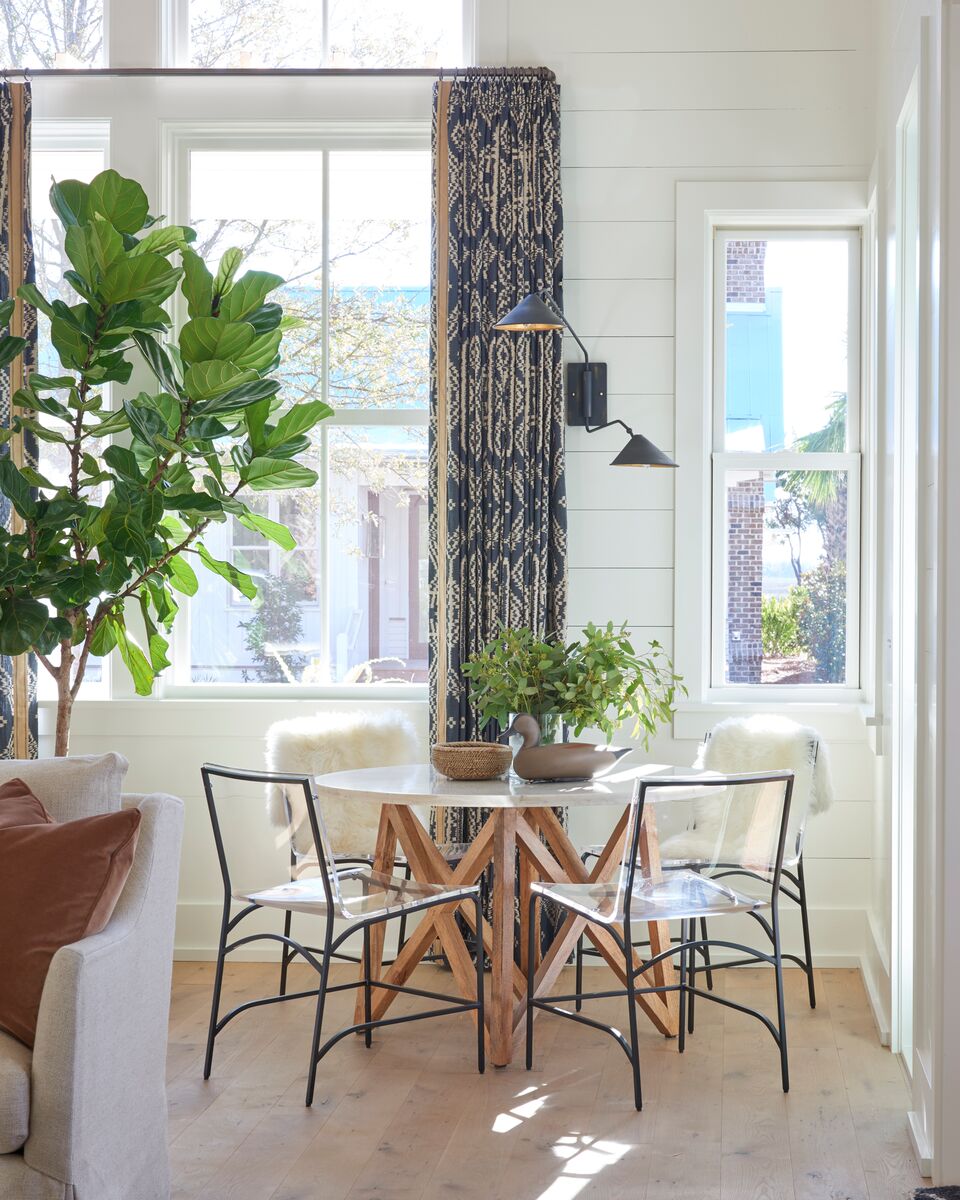
There is ample outdoor living space to enjoy the lush natural landscape that surrounds Moreland Village. Guests are greeted with a welcoming front porch covered with a trellis, and the fenced-in backyard features a screened-in porch for additional dining and a firepit. There is also a carport that can double as a workshop.
Artist Cottage, located at 753 Old Moreland Road, welcomes a new artisan each month of the year — allowing homeowners, resort guests and locals the opportunity to interact and create alongside the makers. The visiting artists — including everyone from banjo and wooden paddle board makers to creamery and cocktail connoisseurs — will host interactive workshops, classes and open studio hours.
Artist Cottage is priced at $1,285,000.
Photos courtesy of Palmetto Bluff.




